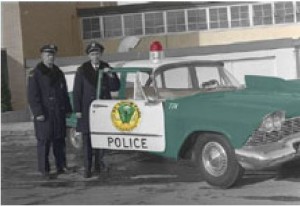Although St. Louis Park wasn’t exactly known for its criminal activity (other than extensive moonshining), here are some interesting accounts of the occasional transgression in days past. These incidents show us just how low key the Village was about crime. This chapter doesn’t pretend to describe every incident, but perhaps this sampling will give us an idea of what the Park Police force had to contend with. As can be expected, many of the dastardly deeds described were perpetrated by denizens of Minneapolis. In fact, records indicate that a suspiciously large percentage of speeding tickets issued in the 1930s were made out to residents of the Big Town of Minneapolis.
The following information came from several sources, including Village/City Council minutes, newspapers, a history of the Police Department authored by retired officer Stan Currie, and police department scrapbooks shared by Joan Reamer of the St. Louis Park Police. Also see Liquor in the Park (which also covers all drug-related crime), Smokin’ in the Boys’ Room, and Early Ordinances.
1868
The first reform school in the State opened in St. Paul on January 1, 1868, on the grounds of present-day Concordia College.
1872
With the rise of the saw mills and flour industry, the population of Minneapolis boomed and with it came an increase of crime. One source says that “The city was infested with ‘tramps.'”
1876
The Younger Brothers camped out with their horses in a ravine that was west-to-northwest of Lake Harriet. From there the 7-8 men went on to rob the Northfield Bank – September 7, 1876.
1877
With the election of John DeLaittre as Mayor of Minneapolis, the police department began photographing people who were arrested.
1878
THE MINNEAPOLIS WORKHOUSE
The City of Minneapolis passed an ordinance on June 19, 1878, creating a city workhouse because the city jail was (already) antiquated and easy to escape from. Prisoners were to be “kept at hard labor…for 10 hours at least per day, except Sundays, either at said workhouse or upon the public city improvements.” This first workhouse was located at 5200 Washington Ave. No., prisoners were put to farming and later brickmaking. This facility was used until 1923.
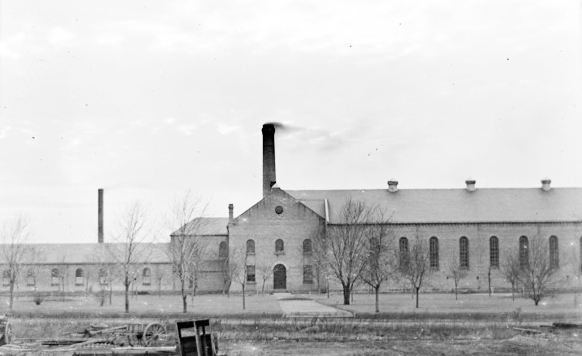
1884
A reunion of the Grand Army of the Republic – Union veterans of the Civil War – took place in Minneapolis, and with it came “pick pockets, confidence men, and robbers” to take advantage of the veterans. The encampment resulted in the killing of two Minneapolis policemen, the first two on record.
1887
The first six ordinances were passed by the St. Louis Park Village Council on April 6, 1887. Given that the area was populated with about 350 people, most of them farmers, the topics of these first ordinances were extraordinary. They dealt with such offenses as disturbance of the peace, disorderly conduct, lurking, lying in wait to pilfer, sweeping empty railroad cars, noise, riot, disturbance, improper diversion, open or notorious drunkenness or intoxication. It was also against the law to appear in a state of nudity, or in a dress not belonging to his or her sex; indecent exposure; obscene or filthy acts; lewd, indecent, immoral, or insulting conduct; exhibiting or offering to see indecent, obscene, or lewd books, pictures; performing in any indecent, immoral or lewd play. Additional ordinances tackled prostitution, gambling, loitering at saloons, taverns, dramshops, or houses of ill fame, and general nuisances. For a complete summary of these first six ordinances, see Early Ordinances.
1890s +
St. Louis Park villagers elected two constables each year. Constables worked for the Justice of the Peace, and had county wide powers to serve court papers. The last Constable was Ed Warner, who worked at the creosote plant during the week, and was a “Sunday Cop” during WWII.
The Village Council President also appointed a Village Marshall, who occasionally locked up a drunk. Police officers were also hired, but on a part-time, pay-per-call basis.
1892
THE VILLAGE JAIL
The St. Louis Park Village two-cell jail was built on land provided by the Minneapolis Investment Company (T.B. Walker’s Syndicate). Joe Williams: “While I was working at the Monitor, I also served as jailer and constable for many years. Our jail was a two room building which stood on the corner of Wooddale and Lake Street. I would walk from home and carry meals to the men being held in jail. We were paid a certain amount for each meal served. The jail clients were mainly drunks and roughnecks.”
In 1902 the municipal jail turned out to be a chronic headache to keep it up as complaints were made to the Village Council that the jail was “filthy.”
In 1905, Art Lovejoy was paid $1.00 for cleaning out the jail in May, but in July the State Board of Health inspected and required that the jail be cleaned. Councilman Stone was empowered to secure bids for painting and putting the jail in “first class condition.” Painting was expected to cost $20. Mrs. E. Depew was reimbursed for providing meals for prisoners.
In 1912, the jail continued to be a problem. At the July 5, 1912, Village Council meeting, the Recorder reported that the premises was inspected by a Mr. Foley of the State Board of Control. He who ordered the Village to repair the floor, plaster the ceiling, and “the cell containing the wood be emptied and cleaned.”
In 1920, Village Council minutes indicate that use of the jail was limited, judging by the money appropriated for meals. In May, a suggestion was made that vines and shrubbery be planted at the jail. No action was taken, but the Village Council did order the Marshall to see that it got cleaned out once a week.
The photo below is from 1932 and features Clayton Swenson and his dog Sandy.
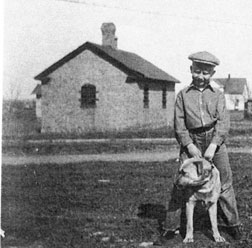
In 1935, the street commissioner was ordered to tear down the ancient jail, but apparently it stood until 1937, when Ed Christy bought the property, tore down the jail, and built his home on the site. That building was itself torn down and replaced by a professional building.
An ordinance dated September 2, 1892 regulated peddlers and hucksters. This was apparently an ongoing problem, as several similar ordinances were subsequently passed on the same topic.
1894
On December 3, 1894, the lifeless body of Miss Catherine “Kitty” Ging was discovered on Excelsior Blvd. (then called Excelsior Road), just beyond Lake Calhoun in the vicinity of the Minikahda Golf Club. The Minneapolis Journal shouted “Foul Murder!,” elaborating that “A Bullet Hole in the Head Tells the Awful Story.” William Erhart, the man who discovered the body, had left the “St. Louis car” at 31st St. and was walking home along Excelsior Ave. [Erhart had attended Pratt School.] Miss Ging, it turned out, had been murdered by the janitor of her Minneapolis apartment building (the Bellevue Hotel, aka “Ozark Flats,” located at 13th and Hennepin).
The janitor acted at the behest of Kitty’s erstwhile friend, Harry T. Hayward, who did it for Kitty’s insurance policies and for the experience of having someone killed. While the janitor drew a life sentence, Hayward swung from the gallows at the Court House (8th Ave So. And 4th Street) on December 11, 1895. In 1911, the death sentence was forever outlawed in Minnesota. For a full account, see Murder in Minnesota by Walter N. Trenerry, Minnesota Historical Society Press, 1962/1985.
1902
The transition from rural to town life was reflected in an ordinance prohibiting cattle, horses, swine, or poultry from running at large inside the Village limits.
1905
F. W. Hudson was Marshall, and one of his duties apparently was burying dead dogs, for which he was paid $1 each.
Nationwide there were only 230 reported murders.
1907
$25 was offered by the Village Council for information leading to the conviction of anyone breaking or damaging street lamps.
1908
Apparently there was quite a gambling problem in the Park, as the Village Council appropriated $100 to gather evidence of persons residing within Village limits who are “permitting and fostering gambling and encouraging and inducing among others minors to engage in such pernicious and unlawful practice.”
1909
An ordinance was passed punishing vagrants and street beggars, which gives some indication of conditions in the Park.
“Poor charge” John Johnson appealed to the Village Council for money for a ticket back to Norway. The Council decided to give him the money, but only when he could show that he had $30 so he wouldn’t be a poor charge in Norway.
1910
An attempt was made to rob the post office, but “the burglars left without getting any loot.” Postmaster Charles Hamilton ran the post office out of his Hamilton Grocery Store, located in the Hamilton Building.
1911
On April 1, 1911, burglars used dynamite to blow the door off the safe in the post office, getting away with about $50 in cash and $200 in stamps. Two mail sacks were found on the M&SL tracks, about 3/4 mile away. “Half the townspeople were aroused by the noise, but early search failed to get any trace of the cracksmen,” reported the Minneapolis Journal. The thieves had apparently broken into a tool shed near the tracks to get two sledgehammers and a crowbar. It was postulated that the thieves entered the building the night before while the Ladies’ Aid Society of the Methodist church had a fair in the hall above the store. The article mentioned that the Sheriff was Otto Langum.
On April 10, 1911, the Minnesota legislature abolished capital punishment in the state for good. Since Statehood in 1858, a total of 26 people were hanged for murder. The first of these, and the only woman, was Ann Bilansky of St. Paul, who murdered her husband with arsenic in 1860. The movement to abolish hanging was in part fanned by the protests of the 1906 bungled hanging of convicted murderer William Williams, who was cursed with a rope that was six inches too long. Approximately 64 people were put to death by the state before capital punishment was banned.
One Jesse Wallace was shot in St. Louis Park, and on May 29, 1911 his doctor appeared before the Village Council seeking reimbursement for expenses. He got it – $139.
1912
A need was identified for a new ordinance dealing with peddlers. The idea was to get them registered and keep them moving, hopefully out of town.
1913
In a memoir, Mrs. Dorothy Hatch Langlie remembered Gypsies traveling through town, engendering the then-common fear of baby snatching. (No such incidents seem to have been reported locally, but see 1934.)
In April, a contingent from Brookside asked the Village Council to name a resident of Brookside a police officer.
In April, John Sandberg became Village Marshall. In July, he was directed by the Village Council to “arrest all vagrants and make proper charges to the end that they secure Work House sentence.”
Tom Christensen was posted at the saloons as a habitual drunk and the Marshall was ordered to take him in whenever he created a disturbance.
1914
This curious item: The case against John and Mary Coles would be dropped by the Humane Society if they would leave town in two days.
Mack Pavey, presumably a constable, was busy catching speeders, and billed the Village for a percentage of the fines. The next year an Andrew Pavey was out “flagging autos.”
In June Village Marshall John Sandberg was instructed to confiscate all slot machines.
1915
Mr. E. Miller of the Miller Grocery on West Lake Street was held up and robbed of $19 by two masked men.
From the St. Louis Park Herald:
Blind Pig Raid
Sunday evening Mack Pavey and deputies raided the blind pig at Lake Street, operated by Hugo (Dutch) Stut, in the little tar shack near the school house.
The marshal let the prisoner in the hands of ex-Constable Bob Anderson, who in sympathy because the man needed clothes, let the proprietor go, and he has not been heard from since.
The people from church through the 4th of July had arrived beforehand and there was an abundance of popping guns, but they were of no avail as the fugitive had already taken to the timber.
Several cases of beer were confiscated by the officers.
1916
Andy Nelson began serving Park law enforcement in 1916. He was quoted as saying “When the Park got two saloons they hired the first policeman!” Andy’s wife took the calls, and when she turned on the porch light he knew he had a call. In the 1950s Andy could be seen riding around town with his pet Pomeranian.
In August 1916, Mrs. Martha Goodspeed, who owned three cottages along Minnehaha Creek, appeared before the Village Council and protested the actions of certain bathers in the creek. Probably those boys swimming nekked again. No action was recorded.
Students at Lincoln High School published the first issue of the Echo newspaper on October 6, 1916. In that first issue was an article about a proposed curfew ordinance that gives a glimpse into life back then.
St. Louis Park has few public amusements to offer its young people. Many of their homes are not made sufficiently attractive for the children to desire to remain there, so roaming the streets seems more alluring. Being as near so large a city as Minneapolis there are apt to be undesirable characters out at night especially in automobiles. Since it is impossible for one policeman to keep a careful watch over all parts of the town the need of the curfew ordinance to force the young people to be in their homes at a certain time becomes apparent. One or more citizens could be appointed in each section of the town to see that after a set hour no children are on the streets unattended or without a legitimate excuse. The curfew ordinance should also apply to the moving-picture show, no child under eighteen without a guardian being allowed therein after a set hour. Because late hours tend to undermine a child’s health the curfew ordinance would serve to promote health as well as morality.
On December 7, 1916, a motion was brought before the Village Council to discontinue the services of Marshall William Hudson “for the welfare of St. Louis Park.” President Vraalstad refused to entertain the motion. It came up again at the next meeting, where a petition was presented to keep Hudson, but he was fired and ordered to give the keys to the lockup to Constable Whipps.
In December 1916 the Minneapolis Morning Tribune reported the midnight robbery of the streetcar on the Como-Hopkins line just a few blocks out of Hopkins. The inoffensive looking passenger pulled a handkerchief over his face and a gun at Conductor G.R. Larson, demanding his money and money changer. Larson objected to parting with the changer, so the robber let him empty it. The “desperado” made his escape out a rear window just before the car reached the Brookside stop.
1917
On April 18, there were five Village policemen (no compensation): A.N. Manlove, H.E. Woerner, J.E. Pockrandt, C.H. Hamilton, and E.P. Whipps, all prominent businessmen.
In June the PTA appeared before the Village Council requesting an ordinance against the shaking of dice. The issue was referred to committee, which determined that it was the State’s jurisdiction. The PTA also addressed the issue of a curfew.
On July 18, the Village Council passed “an ordinance defining and punishing vagrancy.” Instead of being a loafer with no money, this political definition of a vagrant was anyone who taught or advocated “crime or violence as a means of accomplishing industrial or political ends.” In another section, a vagrant was one who taught or advised citizens that they “ought not aid or assist in the United States in prosecuting or carrying on war with the public enemies of the United States.” These were the days after the Russian Revolution, and fear of communism made people a little crazy. This culminated in 1919 with the “Palmer Raids,” which generally deprived a lot of people of their civil rights.
1918
On May 16th, the Village Council passed an ordinance “relative to Fire Works and Discharge of Fire Arms Within the Limits of the Village…” No person shall…explode, burn, or fire off, any rocket, firecracker, roman candle or other species of fireworks or pyrotechnic display…. Nor shall any person fire off, discharge or explode any gun, pistol, or other weapon within the Village limits.” Special permission could be granted to fire a salute or display of fireworks. The ordinance made it clear that the use of a gun in defense of person, property, of family was exempt.
In June, Mr. Z.H. Pattison was appointed Village Policeman, but only for one month in September, with a salary of $150. Come October, A.J. Nordstrom and Joseph L. Elias were named Special Policemen.
Also in October, complaints were heard of misconduct of Policeman Patterson. The Village Council took them under consideration and failed to find them substantiated.
Edward D. Stoops was appointed Marshal following World War I until the late 1920s.
1919
In June the Village Council purchased one “Hi-Way Patrol,” which is presumably a squad car. They also hired Fred Thompson as Special Policeman from June 1919 to April 1920. R.T. Witzel was given a three month trial as policeman starting in September – he had to use his own vehicle and was paid $150/month. The next year he was appointed Village Marshall for the first four months of 1920. The Creosote Plant had its own policeman.
Also in June the St. Louis Park Commercial Club approached the Village Council and requested they pass an ordinance regarding the orderly planting of trees. They also recommended that a policeman be hired year-round.
On August 21, 1919, and ordinance was passed “prohibiting persons under 16 years of age from being on the streets, alleys or public places in the Village of St. Louis Park, Minnesota, at night, after the hours of 9:00 pm , standard time.” The Village Marshall, Constable, or policeman were there to enforce it, and violations brought a fine of $10 plus costs.
In October, the School Board asked the Village Council to give police powers to Janitor Tinsrud.
1920
In February, F.W. Hudson resigned as Constable.
Marshall Wetzel reported his success in collecting fines. In April he printed up fliers to hand out to the law offenders on the public highways. In July, he was appropriated $9.45 for 1,000 index cards. Unfortunately, the story behind that purchase was not recorded.
In July, perhaps in response to unruly behavior, the Marshall was instructed to attend all dances at the high school or have one of his men present.
One of the issues of the day was loose horses and cattle.
1921
The High School Mothers’ Club appeared before the Village Council asking that the curfew be strictly enforced.
1922
In April 1922, two robbers went on a crime spree in Eden Prairie, Hopkins and St. Louis Park, holding up motorists and farmers on Excelsior Blvd. In response, a posse of 200 farmers and villagers armed themselves with rifles, shotguns, pitchforks, and any other weapon within reach. Sheriff Earle Brown got out his two German shepherd police dogs to track the criminals down. One of the bandits was shot but only had $4.05 on him, stating that his partner had all the loot. The injured robber was identified as Joe Porter of St. Paul, who said that it was his first day in his life of crime.
1923
474 acres near Parkers Lake in Plymouth Township became the site of the new Minneapolis workhouse. The land was purchased for $121,612.50. This was also a working farm. More land was purchased in 1929.
1925
On July 1, 1925, it was reported that Marshall Stoops had trouble at O’Hearn’s Cafe on Excelsior Blvd. (don’t know where that was, but they had a bowling team). He complained that he wasn’t receiving proper cooperation. No report on how the conflict was resolved.
On April 8, 1925, Frank Murphy was killed in his home on Minnetonka Blvd. and Grant Street (Brunswick) after a drunken argument with his wife. In front of witnesses, Mrs. Murphy’s butcher knife settled the argument. Although she buried the knife in the back yard, it was discovered, and Mrs. Murphy was indicted.
In 1925 delinquent girls were sent to the Hennepin County Home School for Girls at 4315 Penn Ave. No. in Minneapolis.
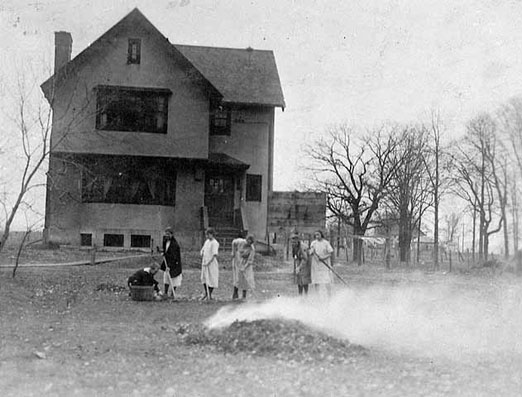
AUTOS COLLIDE; 2 DIE, 7 HURT
So read the banner headline of the Minneapolis Morning Tribune on November 14, 1925. The day before, Friday afternoon, November 13, Andrew Pavey of St. Louis Park was charged with culpable negligence in an automobile collision on Superior Boulevard (Highway 12/394). The location was only given as near the Pershing Inn, which was approximately one mile west of the Minneapolis border.
Mrs. Rose Hivala and her two-year-old son Alfred were killed and seven others were injured. Pavey and one of his passengers, Willard Buck, were taken to the morgue to view the bodies of the victims.
Pavey was indicted on two counts of second degree manslaughter; the trial beginning on February 4, 1926, was for the death of Mrs. Hivala only. The State called 36 witnesses, and the defense about a dozen, including Pavey himself. Some witnesses testified that Pavey was going as fast as 55 miles per hour, while the Christopher car was going about 15. Pavey admitted to going 35 mph and said he swerved to avoid some bad pavement. He was also accused by some witnesses of being drunk; he admitted to have had a drink made up of three teaspoons of alcohol in a soft drink, but denied being drunk and attributed his dazed appearance after the crash to shock. One witness testified that Pavey and Buck tried to flee the scene by hitching a ride back into town. He said that they told him they needed to go the hospital and that they were both bleeding. The witness stopped cars from picking them up. That witness also testified that Pavey had passed his car at a high rate of speed just before the crash and that Pavey was drunk.
Deliberations took 50 hours, a record for a criminal jury in Hennepin County. Charges were dropped by Judge Frank E. Reed when the jury stood hung at 10 to 2 for an acquittal.
He was scheduled for retrial on April 5, 1926. The trial was postponed until April, and criminal charges were apparently dropped.
Pavey’s troubles were not over. The Christopher family successfully sued him for $34,800, and two of his passengers Hester Christ and Helen Beal sued him for $22,080.
1926
On August 9, the far-reaching Ordinance A-16 was passed, which basically re-wrote the laws of the Village. These rules encompassed everything from speed limits to licenses, to public spitting, which was outlawed, to the particular relief of one barbershop/pool hall keeper’s son whose job it was to clean out the spittoons. For details see Early Ordinances.
In 1926 the Council appointed Earl Sewall as the Village Marshall. Special Officers were also appointed on a per-call basis; some of the names appearing in the records of the Council in the 1920s were W. A. Ruth, Walter Moore, Frank Werner, and Andrew Nelson.
1928
13 special police officers were hired by the Village Council on November 7, but they were probably election judges.
1929
On January 22, 1929, Frank Fuhrer complained that Louise Townshend talked provokingly and slammed the door unnecessarily hard at his store, located at 3081 Gloucester Ave. This site is now at the confluence of Glenhurst, Minnetonka Blvd., Highway 7, and Lake Street.
The Post Office was burglarized yet again.
By 1929 Village Dr. Darby reported to the council that the “Village lock-up” should be torn down.
Tony Majures was charged with assault for attacking his wife with a razor intending to do bodily harm. His wife did not come to the trial and sent a letter asking the judge to give him another chance. The charge was dismissed on May 22, 1929.
Theodore Winterfield was charged with disorderly conduct. His wife tried to have him declared insane, saying he was sick and nervous. On August 13, 1929, the court declared him sane and gave him 30 days probation and told him to keep the peace.
The Minneapolis work house, built in 1923 in Plymouth, was expanded by 11 acres at a cost of $4,500. 14 buildings were added, including a cattle barn, “piggery,” and the men’s facility. The women’s section was built in 1953.
1930
This interesting note: future Justice of the Peace William R. Reilly was making his living as a salesman at a wallpaper store in 1930. In that year he lived at 5626 W. 36th Street, a stretch of road that was cleared of all houses in the 1950s but chock-a-block with apartments 50 years later.
1931
Francis J. “Franny” Senander was elected constable in 1930 and took office in 1931, becoming the first full-time police officer in St. Louis Park. Later that year, future Chief of Police Andy Nelson joined the two-man force. Nelson had worked in some law enforcement capacity since 1916.
This bears quoting in full: from the Minneapolis Star, March 19, 1931.
Man Who Arrested His Brother Not to Testify
Although brother arrested brother in St. Louis Park, there will be no trial of the latter with one testifying against the other.
Peter Rossi, proprietor of the Park lunchroom where Earl Sewall, constable, arrested his younger brother, Gordon Sewall, when he found him inside the place after it had been closed for the day, today decided not to prefer charges against Gordon.
Earl Sewall was called to the place when passersby saw someone inside lighting matches. He found the door open and the glass broken out. Drawing his revolver, he entered and a man inside fled. The constable ordered him to halt, threatening to shoot. The fleeing suspect came to a stop and Earl Sewall discovered it was his own brother.
Gordon Sewall was to have been given a hearing before W.L. Scism, justice of the peace, Wednesday night, but when Rossi declined to swear out a complaint against him, the matter was dropped.
Gordon told his brother he had found the store door open and believing a burglary had been committed, he went inside to investigate. It was while he was there that Earl came along and the chase followed. County Attorney Ed J. Goff said today he would issue to complaint against the younger Sewall unless Rossi changed his mind.
Here is the picture of Earl as it appeared in the story:
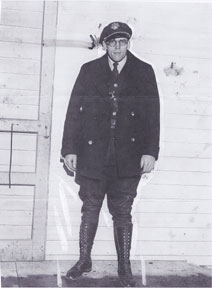
Arthur F. “Art” Hager was appointed to serve as Marshall and Chief of Police by Mayor Kleve Flakne in May 1931.
The Village Council passed an ordinance prohibiting “the sale or other disposal or distribution” of fireworks within the village. Violators faced 90 days and a fine of up to $100. The ordinance specifically excepted organizations such as the VFW and the American Legion.
On September 16, 1931, Park established the “School Police”, i.e., the student safety patrol program. The first patrol captain at Brookside School was Tommy Bates. Bates later served as a bombardier-navigator and was killed in action over Germany in 1944. Each patrol captain had the honor of wearing Bates’ original leather belt, and no matter how old and tattered it got, it was a big honor to wear it. The School Safety Patrol program was founded on February 17, 1921 by the principal of a Catholic school in St. Paul.
1932
By the end of the year, the Depression necessitated that all policemen be reduced to part time. In the 1930s, the police chief had a desk in the hose drying tower attached to the fire station at 3611 Brunswick. “It was OK if there hadn’t been a fire recently, but when they hung the hoses up to dry, it was damp,” explained longtime officer Stan Currie.
1933
A May 15, 1933 article in the Minneapolis Tribune about Art Hager stated that he was the Village’s only policeman, on the beat 24 hours a day.
BURGLARS IN A RUT
On September 11, 1933, eight members of the Barker-Karpis Gang held up the Railway Express Agency in St. Paul using a stolen Hupmobile. Two “burglar proof” strongboxes were taken, as well as guns from REA employees. It was suspected that employees were complicit and they were questioned.
The car was found the next day in St. Louis Park, hopelessly bogged down in a hole at a dead near Texas Ave. and Cambridge Street. A couple who lived at that intersection heard a loud bang, which would have been one strongbox being pried open, and saw three cars and eight people transferring the opened box into the dead car and taking off after a woman said “Oh come on. Let’s go.” They even saw a man in front of their house standing guard – for an hour. And still they did not call the Sheriff. A look at the map shows that Texas Ave. is now the dividing line between St. Louis Park and Hopkins, and the only house existing in 2019 that is old enough to have been there then is now 602 Texas Ave. in Hopkins. But maybe the hole was in St. Louis Park??
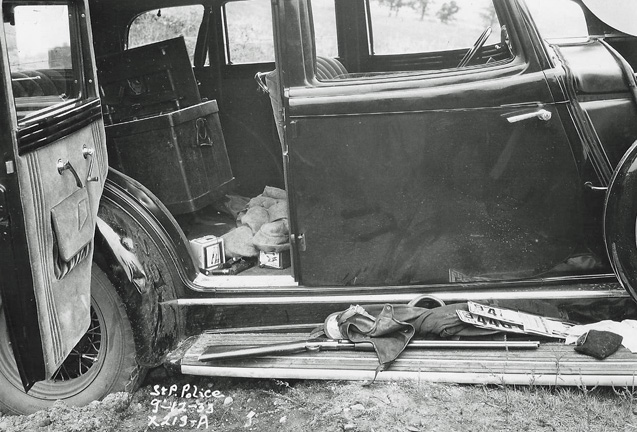
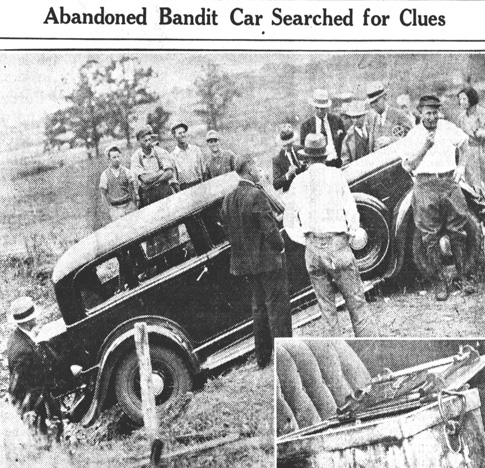
The Mayor of St. Louis Park was apparently peeved about the couple’s failure to call the cops, essentially telling people, if you see something, say something. He instructed Art Hager to “shoot to kill” when dealing with these “deperadoes,” and was also devising a plan to deputising citizens around the Village to provide more protection. (Minneapolis Tribune, September 13, 1933)
CODA of Sorts: Two game wardens in Wisconsin found four well-dressed men burying the second vault near Hayward. It weighed 700 pounds and had been blasted open with nitroglycerine. But the men got away from the wardens and proceed to rob a bank in Amery, Wisconsin.
On October 18, 1933, Hager gave his report as the Village Marshall: 247 radio calls, 192 home calls, found 23 stolen cars, made 7 arrests, investigated 3 holdups and 12 prowlers, helped at 23 auto accidents, and called an ambulance five times.
Mayor Sewall later demoted Hager and made Andy Nelson Chief of Police.
POST OFFICE ROBBED
For the second time since 1929, the Post Office was robbed on August 27, 1933. The robbers got in through the restaurant next door, operated by Mary Paulos. They chiseled through an eight-inch concrete vault that had been built with the building in 1915 when it was the (failed) St. Louis Park Bank. They took $847 in stamps and currency; some of the money taken belonged to the Odd Fellows, and some was the personal property of the Postmaster Langdon. They also took two Colt .45 automatics from the safe.
Ben Brown remembers a guy coming to St. Louis Park on the streetcar with the “Extras” from the newspaper. He walked toward the Center of the Park and everyone just looked at him shouting “Extra Extra Extra, St. Louis Park P.O. robbed!” There were not many homes here in 1933 and the paper man finally said “Where the Hell is the Town?”
On August 29, 1933, a squad of Minneapolis police, deputies, and Federal Postal Inspectors arrested two men at a house at 3009 Natchez Ave. near Minnetonka Blvd. for the robbery of the St. Louis Park Post Office. (The house has since been removed for an apartment building.) Arrested at this first raid were Al Skoog and Harry Paul Kyne. Both had spent time at San Quentin for various offenses. The house was apparently Skoog’s, since his wife was also there but not arrested.
That first raid had been triggered by a letter sent by Kyne to a suspect who had been arrested for a robbery in Denver. Authorities in Denver intercepted the letter and were able to give Minneapolis police the return address on Natchez. (Note to robbers: Don’t put your return address on your letters.)
On notice, SLP police also intercepted a letter sent to one of the SLP robbers from Ernie S. Russell, another one of the robbers then holed up with Arthur L. Brown in Chicago. The letter informed them that Chicago was “hotter than a pistol” and that it was extremely difficult to cash out the stolen travelers checks and express checks, even at a discount. The Chicago robbers had the paper but the city was flooded with bad paper and locals were hesitant to even change $20 bills. Our Chicago bad guys were finding it difficult to raise money to eat. The entire text of the letter can be found in the Minneapolis Star, August 31, 1933, Page 5.
On August 30 Skoog and Kyne were caught red-handed with the Post Office’s strong box, identified by SLP Postmaster Verne Langdon. Also found in the house were burglars’ tools, sub-machine guns, and handguns. The owner of some loose car license plates, and Al Skoog’s brother Charlie were eventually released.
Skoog and Kyne plead guilty and were sentenced to fines of $200 and up to five years in Leavenworth Prison.
Next door in Hopkins, another bank robbery took place on November 9, 1933, at the Security National Bank. The noontime robbery was committed by three armed bandits, with a getaway man/men in a stolen car. Over $5,000 was taken by the polite holdup men, including a 150 pound bag of silver coins. Three of the men were killed in a raid in Chicago a month later, and the other two were never identified. State police connected the men to a gang responsible for a series of six area robberies, one of which could have been that of the St. Louis Park Bank earlier that year.
1934
1934, a Depression year, was a busy one for St. Louis Park, featuring murder, gangsters, and vigilantes. Ironically, it was also the year that the St. Louis Park Police Department started as we know it today, when, on January 3, 1934, the Village Council appointed Andy Nelson and Art Hager as full-time police officers, designating Andy as Chief.
THE THEODORE KIDDER MURDER
On March 4, 1934, perhaps the most sensational event in St. Louis Park history took place when local resident Theodore Kidder was gunned down in front of Brookside Drug, purportedly by (henchmen of ) Baby Face Nelson. Be sure to go to the Kidder page – it’s a fascinating story.
St. Louis Park had a connection to another major crime, when one of the getaway cars of a brazen robbery was found in a ditch at the end of Cambridge, west of Texas. As many as 8-9 men in three cars had stolen two strongboxes from two Rail Way Express agents at St. Paul Union Depot. The car ditched in St. Louis Park had been stolen from a Minneapolis garage, and contained one of the strongboxes (empty), a pistol (taken from Brig Motes, one of the robbed men), a rifle, ammo, and clothes. No word if the robbers got away with the approximately $5,000 in cash and thousands in securities. The police chief in St. Paul allowed gangsters to stay there as long as they didn’t do crimes within St. Paul, so this must have been an aberration.
VIGILANTES
The Park was becoming known as “Little Cicero,” after the working class suburb of Chicago where Al Capone moved his gang in 1923 to escape reformers. Reaction to this gangster activity by the Village was extreme. The summer before, St. Louis Park Mayor Kleve J. Flakne chose a secret central committee of ten men who would aid the police in spotting unusual or illegal activity.
Shortly after the Kidder murder, the Mayor called a meeting “to form a committee of vigilantes to cooperate with police in a war on lawlessness.” Flakne was quoted as saying, “In my opinion, members of our vigilantes should be deputized, and should be given orders to shoot to kill in event of any crime.” 200 citizens attended this meeting at “the school building.” The plan was for the Mayor to appoint a central committee of six, who would then appoint other men until each block had a representative. Plans were made to purchase a machine gun for the police department, put bullet-proof armor and glass on the Village’s sole police car, and put the entire village under citizen surveillance at all times.
Even the kids were in on the fun. In the spring of 1934, Mr. Roy Olson of the St. Cloud Reformatory spoke to the North Side/Eliot Mother’s Club on the present crime wave among our boys and girls.
GYPSIES
The Hennepin County Enterprise, Robbinsdale filed this report from Mountain Lake on March 8, 1934.
A gypsie who asked Reinhart Schriock for a penny to tell his fortune managed to extract $15 from his pocket in the “telling” and nearly got away with it last week. First asking Schriock for a match, the gypsie followed him into the house and started to tell his fortune. Schriock refused, but when she had left he found $15 missing from his pocket. He discovered his loss in time to catch her and get his money back, after which the gypsie hurried away in a car.
MORE GANGSTER NEWS
Edward G. Bremer of St. Paul kidnapped by the Barker-Karpis gang. His ransom of $200,000 was one of the largest ransoms in the United States up to that time. By 1936 the kidnappers had been caught and convicted. Also in 1934, “Public Enemy Number 1” John Dillinger had a gun battle with FBI agents in St. Paul on March 11 but escaped.
On April 9, 1934, Chief Nelson gave Arthur Hager a 30 day suspension for disobedience and neglect of duty and informally advised him to seek another job. Some say it had to do with his handling of the Kidder murder; others say it had to do with the amount of time spent at Reiss’s. It must have been serious – Andy threatened to resign if the Council did not support him. They did.
A “Walkathon” (dance marathon) was held in a tent on Wayzata Blvd., despite the protestations of the grand jury.
Leonard Sengles was fined $12 plus court costs of $3 for taking radiator caps off of cars parked at the El Patio Tavern on November 22, 1934.
1935
Village Council minutes refer to an “outrage” that took place at the Chick Inn on Excelsior Blvd. Some sort of altercation took place between County Deputy Frank Scamek and Nels Peterson, but no further information could be learned, except that the deputy apologized.
In March the Village Council appointed two special motorcycle officers whose job it was to catch speeders coming from Minneapolis on Lake Street/Minnetonka Blvd. At the time, Hennepin County had a “Motorcycle Flying Squad,” which became the Minnesota Highway Patrol. The St. Louis Park squad was discontinued when one of the men got his motorcycle stuck in the streetcar tracks at about the 4300 block of West Lake Street. He crashed his bike and hurt himself.
In 1970 police had contact with 5.7 percent of the school population, ages 7-17.
1936
Mrs. Elizabeth Kienitz was found guilty of assaulting Mrs. A. Wyman by striking her in the face and pulling her hair on July 31, 1936. She was fined $1 and court costs of $4.
Sometime during the tenure of Mayor E.W. Nelson (1936-38), the police force moved to civil service status.
1937
ELIAS vs ELIAS: THE SCISSORS SLAYING
“Stabbed to Death by Wife” screamed the headline of the Minneapolis Star on July 19, 1937. Mrs. Rose V. Elias had killed her husband on July 18, 1937, with a pair of scissors during an early Sunday night quarrel. Joseph L. Elias was a St. Louis Park justice of the peace. Elias was severely stabbed four times in the spleen and breast and had cuts on his hand.
Since Rose had been married and divorced three times before, police investigated those marriages while the case was being investigated. She was not immediately arrested, as the assumption was self-defense. (Minneapolis Star, July 20, 1937) She was held in the Hennepin County Jail soon thereafter, and until she was released on bail on July 30, 1937.
The funeral of Joseph Elias was held on July 22, 1937, at which Rose exhibited “extreme grief.” She was guarded by two deputies and a matron. After the funeral she was returned to the Hennepin County jail, still without charge. (Minneapolis Star, July 22, 1937)
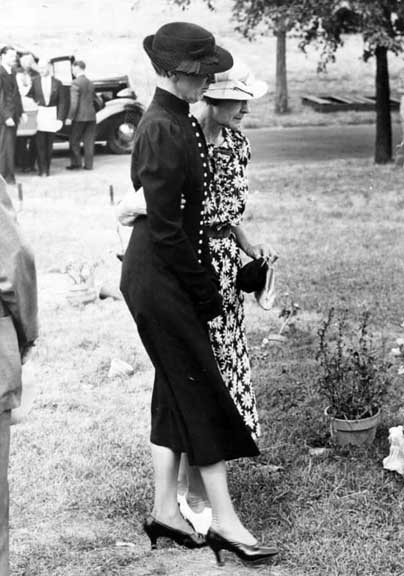
On July 29, 1937, Rose was indicted by the Grand Jury for First Degree manslaughter. She testified that she had the scissors because she had been sewing, but had no memory of attacking her husband. She filed a plea of not guilty.
Rose went on trial for manslaughter in October 1937. Jury selection began on October 5, 1937. She was defended by Kleve Flakne. Flakne was a Minneapolis lawyer who had been a neighbor of the Eliases when he lived in St. Louis Park when he was Mayor in the early 1930s. All of the jurors but one from St. Louis Park were from Minneapolis. Three were women. Their photos were published in the Minneapolis Star on October 7, 1937.
Rose’s testimony at the trial was full of sobs and histronics, according to the account in the Minneapolis Tribune (October 9, 1937). Her statement was that Joe was in a foul mood after she had asked him not to wear his best shirt to go back to the Ford Plant where he worked that night. He banged around and they ate their dinner in silence. Bored, she went to a “beer parlor” at 908 Excelsior Blvd. in Hopkins on the streetcar. She called Joe to pick her up. He smacked her in the mouth in the car. They got home and the argument continued. After another blow, she hit him with the scissors, which she had in her hand to replace a button. She bandaged the wound and then called Dr. E.P. Murphy, 3031 Salem Ave., St. Louis Park. He was then taken to St. Mary’s Hospital.
Joseph’s deathbed statement, given to a Deputy on the day he died and presented at the trial by the coroner, was that she picked at him all the time, about everything. When he picked her up at the beer parlor, she was in a booth with a man. In the car she made a sarcastic remark, so he smacked her. They got home, he went to bed, and he told her to go to sleep. She entered his bedroom and said, “Why can’t I have my own friends too?” Elias replied, “Get out.” She stood over her with something sharp and he felt the scissors. (Minneapolis Star, October 6, 1937) This testimony was read to the jury on October 13, the last day of the trial.
Inadmissable was testimony from Joe Elias’s former wife, Mrs. William Mitchell, who was prepared to say that Rose had told her two years ago that she would use an ice pick on Joe if he assaulted her. Another judge, William R. Reilley, was prepared to testify that Joe had told him that Rose had “beaten him on the head with a rolling pin.” (Minneapolis Star, October 7, 1937)
Emmett F. Haskin, Hopkins pharmacist, was the man sitting with Rose at the beer parlor when Joe came to pick up Rose and testified that Joe was in an angry mood. Three drunks that were seen before Joe in night court also testified that Joe was drunk and didn’t give them a chance to make a plea before fining them.
After 30 hours of deliberation, the jury found her guilty on October 15. On October 19, she was sentenced to 5 t0 20 years in state prison. Flakne requested a new trial, and Rose could have been free if she could raise the $5,000 bail – a committee of friends in St. Louis Park was taking up her cause, but there was no hope. She did have a stay of a week to report to the Shakopee Reformatory for Women, but it was shortened at Flakne’s request (perhaps a grab at sympathy) and she began serving her sentence on October 20, 1937.
On May 6, 1938, Rose’s request for a new trial was denied in District Court. On May 9, 1938, her lawyer filed for a appeal in the Minnesota Supreme Court.
On April 21, 1939, the Minnesota Supreme Court (State v. Elias, 205 Minn. 156, 285 N.W. 475 (1939)) granted Rose a new trial after it disallowed Joseph’s testimony. Deathbed testimony was only permissible in court if the person knew he was dying, and Joseph had made statements about getting a divorce when he got out of there and other things that indicated that he believed he would live. (Minneapolis Journal, April 21, 1939) The Court also cited other errors made by the Prosecution. The transcript of the Minnesota Supreme Court decision can be found here. (Thanks to Jeff Johnston on Facebook!)
Based on the Supreme Court decision, the lower court judge nolled the original indictment, ruling that it would not be prosecuted again. Rose was released from Shakopee on May 18, 1939. After serving 19 months, Rose was free.
Mrs. Elias subsequently went to Oklahoma City to live with a son from a previous marriage. (Minneapolis Star, May 18, 1939)
1939
“St. Louis Park Councilmen Testify in License Quiz.” An undated Tribune article reports that St. Louis Park’s five-man council was called by the grand jury in an investigation into the charge that Emil Pouliot, filling station owner, paid $100 to a man not connected with the council in order to get a license. This incident took place while W.M. Martin was Mayor (1939-43), and as the councilmen kept their jobs, all must have been resolved agreeably.
Also during Martin’s tenure, Patrolman Archie Brown, age 34, was hurt in a motorcycle accident at the intersection of Highway 7 and Minnetonka Blvd. Brown reportedly struck a rut in the road while chasing a speeder. He was found next to his wrecked vehicle and taken to Eitel Hospital with a severe head laceration broken nose, and body bruises. Brown lived in Brookside, at 5518 Vermont Street.
1942
One night in June 1942, two Minneapolis teens robbed Brookside Drug of over $400 in merchandise, and the adjacent Brookside Market of merchandise and $18.50 in cash. Most of the merchandise was in cigarettes, which were found in their car when apprehended by Minneapolis police a week later. Although most of the cigarettes were recovered, the thugs threw Brookside Drug owner Ralph Hunsaker’s typewriter and adding machine into the river.
The Village Council read the riot act to Bunnys owner Henry Aretz that it will not tolerate the violation of the village’s liquor ordinance. Apparently an employee had sold liquor to a minor, although the article in the Dispatch was unclear on the point. Aretz promised not to operate on Sundays, which seemed to placate locals such as Mell Hobart and Lydia Rogers. Dr. L.V. Downing, however, advocating the revocation of Bunnys liquor license, as did the “Excelsior Boulevard Boosters.” Hobart, of 4327 Brook Lane and head of Ministers Life, was a frequent participant at Village Council meetings to protest the goings-on along Excelsior Blvd.
E.A. “Art” Linnee won the first of eight terms as justice of the peace. He would marry hundreds of couples in his living room, with Mrs. Esther Linnee scrambling to find a second witness.
1943
Mike Jennings paid a $400 fine in Federal court for concealing, possessing for purposes of sale, and failing to report a large stock of liquor. This stash, which was found in “one of his homes,” violated a new ruling that required all liquor dealers to pay a Federal “floor tax” on stocks on hand as of November 1, 1942.
1945
Police reported that V-E Day was the quietest day in the history of the force, with not one call received that evening.
“Park Waitress Slain by Lover Near Jordan” screamed the headline. On October 15, 1945, 28-year-old Sally Ricker, a waitress at Lilac Lanes, was found by the side of the road near Jordan, shot to death. She had taken the bus to Jordan with another waitress from Lilac Lanes to see her lover/former lover William Schaak. After a two-year relationship, the Minneapolis woman refused to marry him. The three took a ride; he stopped and opened the trunk. The girls ran, but he shot Sally in the shoulderblade near the neck with a shotgun and she fell. Her friend ran to a nearby farm for help. Schaak fled, then surrendered: “I don’t know why I did it.”
Marvin Burandt, a 24-year-old Waconia farmer, received a 90-day sentence for a hit and run in April. Patrick Butler, a 75 year old bartender at Al’s, was critically injured. Park Police traced Burandt to his home, where he initially denied his involvement until officers saw his damaged car behind the barn.
1946
The Village bought an Adams Motor Patrol for $8,433.20.
Officers Carl Iverson and Don Whalen, called to 4144 Brookside Ave on March 26, 1947, found Frank J. Probst lying in a pool of blood in his garage. It appeared to be a suicide, as police found a gun beside him and writing scrawled on the walls of the garage saying his wife should not be blamed for what he had done. But Probst was right handed and was shot in the left temple; that and the fact that $1,000 in cash was in the glove compartment of the man’s car lead the police to continue the investigation. Quick work by Dr. Murphy saved the man’s life; indications are that he lived until 1983.
In October, neighbors complained about rowdyness at Eaton’s Riding Stables, aka the Pastime Arena.
1947
Special police were again dispatched to Pastime Arena.
Three saddles were stolen from the barn behind Delano Dairy on Excelsior Blvd. In September, Police Chief Andy Nelson was commended for his assistance in finding the criminals.
Alfred Hay complained to the Village Council of frequent shooting at corner of Texas and Minnetonka Blvd. (not yet developed), but was referred to the Police Department.
Justice of the Peace H.J. Kuhlman moved to Morningside in June.
1948
Clyde Sorenson joined the 7-man police force. He would become Chief in 1959.
Special police were again assigned to the Pastime Arena, and a roller rink ordinance was passed.
Shooting guns in the Village was restricted to a person’s own property.
The curfew for those under 16 was changed from 9 pm to 9:30 pm. It was marked with a siren.
Police cars were bidded out, and had to be 100 HB, 8 cylinder, Tudor, black, with overdrive. Dahlberg motors in Hopkins quoted $1663.59.
1951
Ten paid, full-time policemen and one part-time officer staffed the force. They used three radio-equipped patrol cars.
A crime wave hit Excelsior Blvd. in June when thieves hit the DS Service Station at 4701 Excelsior, breaking a glass pane in a door at the rear of the station. They next used a crow bar from the gas station to break into the Boulevard Drive-In across the street, swiping candy bars, cigarettes, and ice cream. Then they proceeded on to offices at the rear of the Joppa Drug Store by prying open a window, but didn’t find anything interesting to steal. Police presumed that the thieves were kids, from the nature of the items stolen; the Dispatch deemed them “hardworking” for their efforts.
Juvenile Delinquent Thomas Kilbourne led police on a chase in a stolen Mercury. Three policemen caught the 16-year-old, first by ramming their cruiser into the Mercury’s side, then firing 8 bullets, and finally causing the stolen vehicle to roll over on a hydrant at Kentucky and Cedar Lake Road. The boy was a veteran of Glen Lake School for Boys. The Mayor later praised the police for their alertness and persistency in capturing the young man.
The Brookside Dairy Bar, at 5922 Excelsior Blvd., was robbed of money and drinks on October 22. The robbers broke a back door window to get in. They absconded with $127.14, a case of beer, and a case of pop (for the getaway driver?), reported the proprietors, Mr. And Mrs. Joseph H. Gagnon.
On October 6, Mayor Hurd “expressed thorough disgust” over the fact that only 35 arrests were made during September for traffic violations. By the end of the year, 952 arrests were made, mostly speeders.
In November, thieves relieved Morton Arneson of a 400-lb. Safe. Next door, at the St. Louis Park Medical Center, the rascals took off with narcotics and cash.
On September 24, 1951, Pockrandt Lumber and Fuel wrote a letter to the Council commending police action when boys wrecked trucks at the site.
1952
Members of the police force became unionized on October 25, 1952, becoming members of Local 224, American Federation of State, County, and Municipal Employees. Robert Standal acted as bargaining agent.
1953
Things were no better, crime-wise, in 1953. A rash of break-ins was reported in February. First stop was the Star-Brite Co. at 4414 Excelsior Blvd. Manager Len Ring reported a loss of $122 from the night safety box.
Next was the Midwest Badge and Novelty Co. at 4420 Excelsior Blvd. Despite the break-in, owner Frank C. Collins reported no losses.
Finally, the thieves broke into the Park Boulevard clothing store, also at 4420 Excelsior Blvd. Manager Joe Ginther reported $38.55 stolen from the cash register. Many more break-ins all over the Park were reported that day. Those juvenile delinquents.
A women’s facility was added at the Minneapolis workhouse at Parker’s Lake. The cost to the Village to send a prisoner to the workhouse was upped to $3.50 per day effective October 1.
Police Chief Andy Nelson was named the Outstanding Citizen of the Year by the VFW on April 17, 1953.
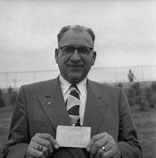
1954
The police force was up to 15 men and 4 patrol cars, woefully inadequate for the booming Village that was about to become a City. The officers traded off patrolling either north or south of Highway 7.
The Department bought a T 43G1 Mobile Transmitter and receiver, operating frequency of 154.310 KC, 25 watt power. Cost: $472.
The Village Council passed a Christmas Tree Ordinance in November.
In May there was a robbery at the Minnesota Silicone Rubber Co.
1955
On January 7, St. Louis Park went from a Village to a City.
23-year-old Dennis H. Lahr, 7515 North Street, was taken into custody for auto theft and check forgery in North Carolina in January. He stole the car from the Super Valu parking lot, from a relative he was living with. When he and the car both went missing at the same time, the chase was on.
In April the Police Department took delivery on four new squad cars. The 198 horsepower Ford V-8s could do 80 mph in second gear and had “a high speed rear end and extra heavy body.” Standing by their new cars were Bob Sorensen Clyde Sorensen and Bruce Aplin. A fifth chief’s car was on order.
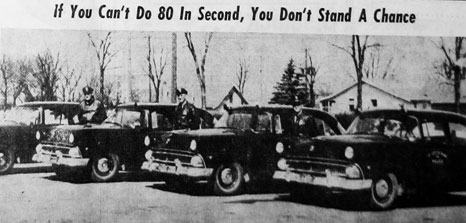
Citizens State Bank was robbed of $9,600 on June 25. The lone armed bandit got clean away under a hail of bullets and was never caught.
[This isn’t exactly criminal (well, maybe a little) but where else to put it?] 1955 was the year of the great automat debate, when inventor Louis Roberge put an automatic food vending machine in a makeshift store in a garage at Meadowbrook Manor. One of his 12 items was a paper carton of milk, and there was much skepticism about how he could keep his product fresh and the premises clean. Many folks saw this one machine as a huge threat, including the Meatcutter’s Union, Milk Drivers and Dairy Employees Union, and the Minneapolis Retail Grocers Association. One man saw this machine as a threat to “the entire working class.” Another school of criticism was that “money comes from the East, goes back East.” Another fear was that cereal could cause rust or mold. Apparently the biggest opponent was Edward Straus, who got caught by Roberge opening windows in Roberge’s place in an attempt to raise the temperature. This led to fisticuffs, but no one was seriously injured. Police declined to press charges against Roberge.
All that notwithstanding, Roberge’s permit was approved on July 11, 1955. Such machines had previously been installed in Minneapolis and Richfield and one was on display at 33rd and Lyndale. Roberge opened his store in July 1955 – sans milk. His other products were bread, eggs, oleomargarine, doughnuts, rolls, butter, bacon, wieners, ground round steak, and coffee. That September, the City Council worked to pass an ordinance to regulate and license vending machines. They attracted national attention, as it was the first of its kind in the nation, according to the Dispatch.
In August 1955 the Traffic Violations Bureau was established.
These were apparently not Happy Days. In October 1955 the Council was asked to pass an ordinance against “window peeping, trespassing, concealed weapons, stick knives, etc.”
One of the issues that the Council and Police faced was the shooting of guns within city limits. It appears that the right to shoot was curtailed for the first time during this time. In November 1955 Mrs. Luverne E. Noon requested permission to shoot squirrels on her property at 6232 Oxford. Permission denied.
In December 1955 a bandit broke into the house of Mr. and Mrs. Art Drew of Golden Valley and demanded keys and the combination to the safe at Witt’s Super Value at 4100 Minnetonka Blvd., where Drew was manager. An accomplice went to the store and robbed it of $4,500, returned for the first bandit an hour later, and they fled. Drew and his wife worked free of their bonds and called police.
1956
In January 1956 a prominent Park developer was held for the shooting of Albert C. Anderson of Minneapolis, the “alleged rival for his wife’s affections” according to the Dispatch.
The Park Plaza State Bank at Knollwood was robbed of $18,195 by a lone, threatening gunman in June 1956. This was the biggest robbery in the Minneapolis area in 24 years.
Jennings was robbed of $10,047 by two “almost friendly” armed bandits.
$5,000 was stolen from a safe at Witt’s Market, and $4,500 from Penney’s Market’s safe. The Red Owl and Miracle Mile was robbed of $1,100.
In April 1956 the SLP Police were ordered to buy new uniforms which were, well, uniform. They also repainted their cars to make them more visible as police cars. The beats were divided into three parts of the city, as divided by the east-west railroads: north of the Great Northern, between the GN and Milwaukee Road/M&SL, and south of the double tracks.
In about 1956 the police department moved into a Quonset Hut that was attached to the fire station next to the old Village Hall. They would remain there until 1963 when a new City Hall was built.
Park police obtained a device called the Trafficorder, which they found to be better than radar in catching speeders. Two pneumatic tubes, 40 inches apart, are stretched half way across the road. They are connected by electrical cable to the Trafficorder in a van parked several hundred feet away. The device measures the time it takes the front wheel of a vehicle to cross both tubes and from that computes the car’s mph. While radar picks up on the first or last vehicle in a group or the biggest or fastest in a group, the Trafficorder picks up every vehicle and indicates speed on a graph. The police department used this device for more than 30 years.
In November 1956 a new curfew went into effect. Children ages 14 and under had to be in by 9:30, and those 15-17 had to be in by 10. Businesses condoning loitering were subject to a $100 fine. (Echo)
1957
Park’s first policewoman was hired in January. Dorothy Olson was in charge of the new FBI-approved records system and also helped search and interrogate women prisoners.
Robert Schmitz of South Street was found in Minneapolis wearing a chain after being reported missing for 10 days. His preliminary diagnosis was a nervous breakdown, and he was taken to University Hospital.
On May 14, 1957, Jerome M. Goldberg, 46, was killed with three blasts of a .12 gauge shotgun by his 16-year-old son Norman. Jerome had ordered his wife Belle and children out of the house – Norman returned and killed his father, allegedly in self-defense. Goldberg was a plumber and lived at 3041 Brunswick.
On May 27, 1957 a Mr. C.W. Hollenbeck complained of disturbances at Myrt’s Diner, a hangout catering to teenagers. The diner, located at Dakota and Minnetonka Blvd., was run by Myrtle and Truman Hedwall. Mr. Hellenbeck complained of loitering, profanity, kids out after curfew, racing, and apparently someone was out there with a bullwhip. There was some back-and-forth about whether the police were told to back off of the place or to strictly enforce local ordinances.
The St. Louis Park Theater was held up in August 1957.
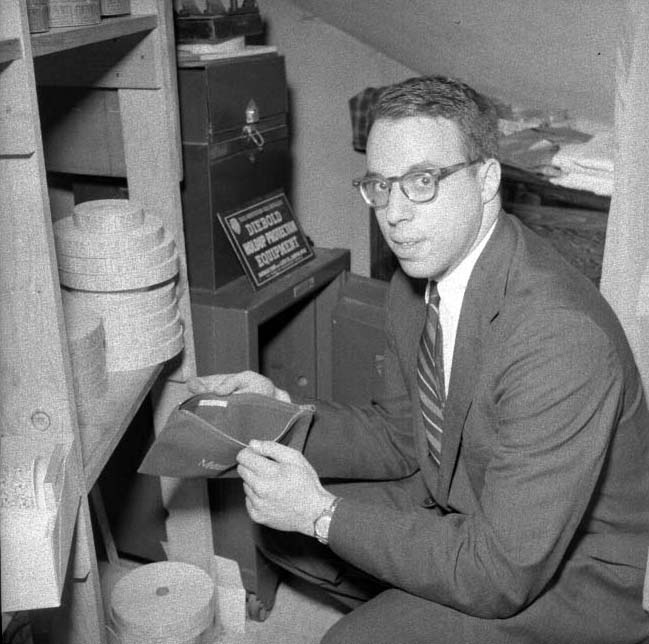
Morris Fink, 30, of 2825 Rhode Island Ave., got $6,000 in 13 stickups of loan companies. He was known as the “sun-tanned loan company bandit.” After obtaining $150 from the Local Loan Co. at 5407 Excelsior Blvd., he was caught, partly because of his gaudy getaway in a pink and black Mercury.
In October 1957 the Minneapolis Tribune reported that Park resident Meyer (Makey) Gordon of 2815 Sunset Blvd. pleaded guilty in Minneapolis municipal court of keeping his Minneapolis Bar open after hours and was fined $100. Gordon was arrested by morals squad officers in a raid at Curly’s Cafe, 20 So. Fifth Street, at 1:50 am on January 15. Gordon’s attorney, Simon Meshbesher, explained that most of the 22 people in the bar at the time of the arrest were employees or friends of employees who were waiting for their friends to finish cleaning up. Gordon insisted that no liquor was served after hours.
Not a crime, but police responded when Herman Winkleman was trapped and rescued from a cave-in in October 1957. We just happen to have good pictures of this one – see below:
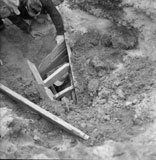
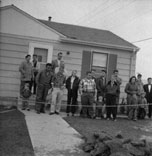
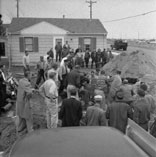
On November 14, 1957, 15-year-old Dennis Lepp killed his stepmother with a .20 gauge shotgun at their home at 3145 Texas Ave. The Minneapolis Star reported that because his grades were slipping, his stepmother suggested that he study instead of going roller skating after school. He went upstairs to his room, loaded his brother’s shotgun, went down and shot Mrs. Lillian Lepp in the back. Dennis ran to the Creosote Plant to hide for a few hours, then came to the Park Standard Service Station at 5551 W. Lake Street and hid in the bathroom. When told by the attendant to go home, he said he was in trouble and told the attendant to call the police. He confessed to the crime, saying he had planned it the day before when Mrs. Lepp also refused to let him go skating, going so far as to steal $100 and ask where the railroad station was. Mrs. Lepp died at Mt. Sinai Hospital.
On December 12, 1957, 57-year-old Axel Christianson set fire to his own house at 2817 Zarthan Ave. Firefighters found him drunk and angry over a pending divorce. His family was not at home at the time.
1957 was a stylish year, and the St. Louis Park Police Department followed suit. Below is a colorized picture done by Mark Muckelberg of the retired PD organization. Pictured to the right are Officers Fred Stimson and Robert Standal.
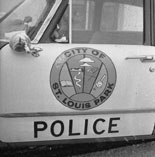
1958
Two St. Louis Park policemen captured three suspects in the burglaries of homes in St. Louis Park, Minnetonka, Minneapolis, and rural Anoka County. The trio was nabbed at Wooddale and Lake St. as they were preparing for another break-in. The suspects confessed to break-ins at gas stations, bars, and an appliance shop. When caught, police found a burlap sack under the front seat of the car containing $150 in bills and coins.
A Minneapolis paper dated June 7, 1958 reported that Michael M. Lyons, 18, was stabbed to death in the front yard at 3037 Cavell. Richard Erickson, 20, was accused of manslaughter. The scuffle followed name calling. Erickson lived at 5921 W. 34th Street in the Park.
In September 1958, Mr. Harold H. Hoffman of G&K Cleaners, 4501 Excelsior Blvd., appeared before the City Council asking for damages for bullet holes when a burglar entered and fled from Jennings Liquor Store, which was across the street. Why he was asking the City and whether he got restitution are lost to history.
1959
Richard Foley, 19, of 4121 Ottawa Ave. and his brother Don, 25, of Minneapolis stuck up the North Commons Tap Room of $145 and the Rail Inn of $400, both in Minneapolis. Of the “gunslinging brothers,” Don admitted his wrongdoing, but Richard refused to talk. (Minneapolis Tribune, January 7d, 1959.)
Much excitement over a stolen car on Minnetonka Blvd. near Joppa, as Sgt. Henry Carlson fired several shots to warn the thieves to stop. Careening wildly, the car crashed over lawns on Princeton and Monterey Parkway and crashed at 28th Street. Three youths ran into the nearby swamp, but were later arrested at their homes. Turns out they had also stolen a 1958 Chevy station wagon. The boys were ages 14 and 15, and two of them were on probation from Glen Lake School for Boys.
Andy Nelson retired on June 30, 1959, at age 71. 250 people came to a dedication dinner at the Park Terrace restaurant, sponsored by the Chamber of Commerce. The Minneapolis Auto Club News attested that Nelson had coped with the likes of John Dillinger, Baby Face Nelson and other hardened criminals during his 30 years on the force. A group police force photo with Andy appeared in the Dispatch on July 30, 1959. Andy died on February 13, 1970.
Clyde Sorenson, another Brookside resident, became Chief on July 1, 1959 and served until 1974. Sorenson was first appointed as patrolman on July 1, 1948. In 1954 he was appointed as the city’s first juvenile officer. He was appointed sergeant in 1956, and lieutenant in 1958. During his tenure he helped establish Police Explorer Post 505 for boys between ages 15 and 19, one of the first in the country.
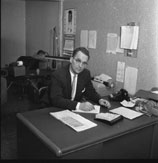
Thomas A. Robinson, 51, had been fired from his City job for drinking. On September 3, 1959, he came to the home of City Manager Tom Chenoweth to plead his case, armed with a 7” Navy K-Bar hunting knife. According to Chenoweth, Robinson threatened to “rip me open from my belly to my throat.” Tom’s wife and a friend came in on them, and Robinson went out to his car, which contained whisky, beer, and a loaded deer rifle. The police got there pronto and apprehended Robinson, who got three years at Stillwater for his trouble. The Dispatch took on a tabloid approach to reporting the story: “Vengeful Ex-City Employee Assaults Tom Chenoweth With Hunting Knife; Wife’s Arrival Averts Tragedy!”
One Rex Roger requested a special permit to erect a radio transmitting and receiving mast in connection with a home occupation, namely detective radio dispatching, at 7709 W. Lake Street. The request was subsequently withdrawn.
1960
Local courts changed from Justice of the Peace to Municipal Court on January 1, 1960. When a recalcitrant defendant charged with speeding demanded a jury trial on December 31, 1959 and when only eight jurors showed up, Judge Anton Yngve ordered the bailiff to use a little-known law to grab jurors off the street in order to hear the case before the JP’s authority ended. The instant jurors consisted of a salesman on a business call in City Hall and three others on their coffee break in a nearby cafe. Mrs. Genevieve C. Mengelkoch was found guilty of doing 40 in a 30 mph zone and was fined $20.
$14,034.17 was pilfered from the School District by 23-year-old payroll clerk LoRayne Beverly Godfrey over a period of three years.
Twin sisters Jane and Janet Goblirsch, 28, were caught with $8,000 worth of goods stolen from 35 stores (not in St. Louis Park). They gave their address as 4425 – 36-1/2 St.
Two children were shot dead in separate shootings that took place two blocks and two months apart. 2-year-old Scott Langbehn was killed when a revolver he was playing with accidentally went off. Robert Jerome Halvorson, 16, was found dead of a shotgun blast.
In August 1960, a Metropolitan Police Radio System was approved to be purchased by the City Council.
“Halloween Hoods Fire Park Home” screamed the headline on November 3. On Halloween night, vandals started three fires in a vacant dwelling at 4525 W. 38th Street. The building was owned by Jerry Holt of Holt Construction Co., 6100 Excelsior Blvd. The fire was being investigated by Chief Williams and the Minnesota fire marshal’s investigators. Damage was estimated at $2,000.
On November 23, 1960, Acme Stone and Lumber commended police for work done in saving their property.
1961
$10,000 in New Year’s Eve proceeds was stolen at gunpoint from manager Paul B. Haugejordan from Al’s Bar in the early hours of January. Paul didn’t see his assailant’s face, as he wore Groucho glasses.
On April 3, 1961, residents appeared before the City Council to commend police officers for excellent work in the solution of serious crimes.
In August, Roger R. Connly of Bloomington embezzled almost $25,000 as secretary/treasurer of Patchin Appraisals over the course of three and a half years. He was given 3 years probation.
The Police Department had two patrol units on the street.
1962
In April, Patrolman Paul Gramer sold his dog Spook to the City for $1. Gramer had worked with Spook for four years, practicing finding lost kids with Patrolman Percy Morris’s 3-year-old son. The 90 lb. German Shepherd took commands in German so shouts of “sic-em!” wouldn’t set him off. He was used periodically in Minneapolis, which had no dogs – St. Paul had several.
On August 2, 1962, a thief took $545 from Perkins Pancake House, 4150 Excelsior Blvd. He must have cut himself in the process, as blood was left at the scene.
In October 1961 Mr. and Mrs. Leonard G. Peterson made the inflammatory charge that St. Louis Park was the home of two teenage gangs: the Baldies, who shaved their heads and wore steel-toed shoes, and the Animals, who had razor blades in their shoes and bit their victims with their filed teeth. The City Council, the Police, and the School Board hotly denied the existence of these gangs – said to number 75-100 each – in the Park.
In November, thieves took off with $1,000 from the Post Office.
The Police Dept. annual spring smelt fry was discontinued in December 1962.
1963
In January the force added 10 new officers, bringing the total number to 41 [23, 33]. The new men were chosen from 140 candidates. Beginning pay was $452/month.
In April, Park obtained radar technology, and used it to write up ticket after ticket.
Citizens State Bank was robbed of $10,000 by a lone bandit in June. The robber got away, despite the four shots from a deer rifle that came from Bank President Allan R. Burrill. The license number of the getaway car had been jotted down by an alert employee, but the car was found abandoned in Minneapolis.
The Echo reported a new Police Cadet program starting in July 1963 for candidates ages 18-21. Participants would be civilians with no power to arrest and no gun. They would be paid $300/month.
The Police Department moved from Fire Station 1 to the new City Hall in October. The new digs included a new jail – in the past, perpetrators had to be taken downtown to the Hennepin County hoosgow.
Patrolling the City on Halloween were six cars of ham radio operators from the Minnesota Emergency Communications, Inc. In 1964, nine cars hit the streets.
In December, an armed robber accosted the manager of the National Food Store (3704 Highway 100, next to Topps) at his house and forced him to drive back to the store and open the safe. The robber, drinking heavily, then forced Manager Robert Bagan to drive him to 17th and Queen Ave. No. in Minneapolis.
Richard T. Peterson, 20 and Robert A. Guthier, 18, from Minneapolis were arrested on December 18, 1963, charged with six holdups and six car thefts. One of the holdups was at the Texa-Tonka Pure Oil Station at 7921 Minnetonka Blvd. They got a whopping $365 total for their trouble.
1964
The new Police Headquarters included an indoor pistol and rifle range, which was used by kids enrolled in a gun safety class offered by the VFW.
In May there was a rash of burglaries of women’s shoes – pairs and singles – in the Westwood Hills area.
On May 18, Patricia Schilken, 21, was shot dead in the head by her estranged husband, Stanley S. Schilken, 29. Her companion, Edward Benson, 21, was also shot in the chest and paralyzed. Patricia had just moved into a basement apartment at 3390 Louisiana from her home in Maple Grove, living with her sister and one of her young children. Stanley was a graduate of the Glen Lake School for Boys and had previously been up on charges of exposure and molestation of a 14-year-old girl. He suspected that his wife was having an affair with the owner of the painting business he worked for. He was captured the next day in a garage in Minneapolis, convicted of 2nd degree murder, and given 40 years.
“Gypsy Fortune Teller Sought by Park Police” ran the headline in the Dispatch on June 18. “Sister Mary” had allegedly bilked $3,000 from an elderly Minneapolis woman “with a trick involving fortune telling.” Police warned the populace not to turn to Gypsies for roofing, painting, car work, or blacktopping. They were also known for pickpocketing, especially at Twins games.
Beware of knife-wielding blondes: on June 12, 1964, a man from Sioux Falls chatted up an attractive blonde at a bar and treated her to dinner at Mr. Q’s, after which she robbed him of $200 at knifepoint. The money was part of the take from the Jewel Box Restaurant, which the victim co-owned. He told police he normally put the money in the safe, but that night he forgot.
On August 27, 1964, “Police Chief Warns Against Shooting Dogs,” citing an expensive French poodle had been badly injured by a BB gun.
An “Indian Spiritualist Reader” took $7,000 from an Edina woman to lift a curse on her home. The perpetrator was a “Mrs. Kay,” a/k/a Katherine S. Reed or Katherine Santello, who lived at 4113 Excelsior Blvd. Mrs. Kay had advised the woman to mortgage her house, then took the money to a Pow Wow to be blessed.
Park National Bank, 5219 Wayzata Blvd., was robbed of $55,000-$60,000 by two armed men. The two were arrested in Wyoming and Montana. At the time it was the third largest bank robbery in Minnesota bank history.
1965
In January, a kangaroo court was convened to pass judgment on retiring municipal judges Anton Yngve and John C. McNulty, who were accused of conspiracy to practice justice. Yngve’s court-appointed lawyers were his sons, John and Albert. Kenneth Wolfe served as prosecutor. Character witnesses came forward and sang the praises of the retiring judges. After a proposed necktie party was defeated, “Judge” (City Attorney) H.H. Burry imposed the sentence: “The best of luck and continued success in your practice of law.”
An ordinance prohibited motorized vehicles on any body of water in the City.
In May, Mrs. Violet E. Bonini was found dead near the edge of a swamp on 27th St. between Colorado and Dakota. The victim, age 46, was divorced with three kids.
Shoplifting was getting to be a real problem – a couple of stores were so plagued that the City was considering raising the retail license fee to recoup police costs.
Police had one car with a Stephenson radar unit, which supplemented the department’s electronic speed check equipment (two hoses spaced in the road).
Harold Gene Leach was charged with burglary, possession of burglary tools, assault stemming from a bar fight, and intimidation of a Federal witness. He was sent to Stillwater State prison, to be handed over later to Federal authorities.
Wolfe Lake was the place for kids to gather and drink, smoke, and who knows what all. In July, 45 kids from a Minneapolis dance hall made their way to the scene, only to be confronted with the police.
In August the police department got a new motorcycle, allowing them to catch speeders on Highway 100 who were going 60 in a 45 mph zone. Remember, 100 still had a fair number of stoplights along the way.
Someone threw a Molotov cocktail at Betty’s Cafeteria, located on the Minnesota Rubber compound. Damage was minor and limited to the door. The action may have been related to a strike of about 300 workers that started on July 29, 1965.
On October 14, Orlo A. Hemstock of 3400 Xenwood was arrested with his 18-year-old son and two other young people (one age 13) for more than 20 burglaries in St. Louis Park, Minnetonka, Hopkins, and Edina. Hemstock, 52, was given 5 years in Stillwater – the others were given probation. The judge was incensed, telling Orlo, “nobody is going to miss you” and that he was “no good to his family or society and was an evil influence on his children and neighbors.” He also told one of the young defendants to “get a haircut.”
Dr. Fred Lyons, the first president of the St. Louis Park Human Relations Council, was arrested in Alabama for practicing medicine without a license.
1966
On the morning of July 25, Eugene Kilmer shot and killed his wife near her home in Minneapolis. A few hours later, Kilmer called his pastor, Rev. Ralph Erickson, and told him he was at Knollwood Plaza. Police and Erickson found Kilmer there, threatening to commit suicide. With the help of Erickson and Hennepin County Deputy Sheriff Joseph Jeremko, who was a friend of Kilmer, he surrendered without further incident. Kilmer was charged with first degree murder and held on $30,000 bond.
There were 12 shoplifting cases in one week in September 1966. Most took place at Target and Shoppers’ City.
Hoigaard’s was robbed of $1,100 in hunting equipment and vending machine coins by burglars who gained entry through a ventilator fan in the roof. They did not get the safe.
1968
Gun Control and snowmobiling ordinances were passed in 1968.
Burglars hit the Post Office on Wooddale Ave. one July weekend, breaking a front door lock and ripping open a safe. Their take was unreported, but they left their tools behind. The Colonial Office Building on Excelsior Blvd. was also burgled, but the prowlers were scared off before they could make a big haul. They, too, left their tools behind.
A disgruntled customer got mad at the man working the overnight shift at the Holiday Station across from Brookside Drug… and took a few shots at him through the side window. The intended target hid behind a stack of Holiday pop and wasn’t hit. He was an older man and didn’t seem at all fazed, and stayed on the job. Below is a photo that Emory Anderson took of the bullet holes in the glass the morning after.

1969
A three year old girl was kidnapped from her bedroom during the night of May 27-28. She was found on June 3 in Oak Hill Park, naked, bruised, and with a broken jaw. There were no immediate suspects.
On November 21, 1969, three men were arrested in a brawl at George’s in the Park, which apparently was not unusual. As many as 20 people took part in the melee, and two employees were injured. One of the suspects got away, but got in another fight in the middle of the street and was apprehended.
1970
In October, police obtained Vascar technology – that’s Visual Average Speed Computer and Recorder. The system was not radar, but used landmarks to check speed. The Department used it to rack up 50 tickets in six weeks.
The first wire tap used in Minnesota, conducted in April 1970, helped apprehend a 29-year-old Minneapolis woman on May 12 at the Ambassador Motor Hotel, 5225 Wayzata Blvd. Ruth Ann Schlosser was convicted of prostitution and possession of hashish.
Crime had become a serious problem for retailers, so the Chamber of Commerce sponsored a Security Seminar, attended by 100 businessmen, on November 10, 1970. The seminar, held at City Hall, featured speakers on shoplifting, bad checks, and internal security. In a related item, the Pinkertons were actively recruiting in the area.
Michael Ross Mastrian, 29, was captured at Perkins Cake and Steak (4150 Excelsior Blvd.) after robbing First Federal Savings and Loan of $2,179 on November 13, 1970. He was arrested by the FBI, with the assistance of St. Louis Park Police.
Perhaps in response to flower power, the department moved away from black and whites and started using cars in various shades of blue, thus portraying a “softer image.” The blue cars lasted over 20 years.
In 1970 police had contact with 5.7 percent of the school population, ages 7-17.
1971
George Schaumberg, owner of George’s in the Park, was robbed in his home of $1,400 in cash and jewelry. His assailants were described as armed and potbellied.
Roy Anderson of 3305 Zarthan shot at his wife with a rifle. She ran across the street to call Police, but he got off 14 shots before he was subdued and charged with aggravated assault.
There were 157 domestic violence calls in 1971. At the time the issue was treated lightly, with men joking about Maggie and Jiggs, two characters in the comics who beat each other constantly.
Vandalism at Park High was a serious problem, with the Echo pleading “STOP IT!” Students were drawing and carving on walls, breaking windows, setting fires, stealing from cars, kicking in lockers, writing on desks, tearing and removing screens and throwing them out the windows, destroying thermostats and fire extinguishers, removing bathroom doors, and even leaving footprints on the ceilings of bathrooms. One girl told of throwing a toilet down an elevator shaft. In 1971 there were 1,066 juvenile violations, ages 7-17, compared to only 370 in 1959.
1972
In April, an 18-year-old was kidnapped at knifepoint in St. Louis Park by two men asking directions to Rose Street. They rode around for awhile and dropped him unharmed in St. Paul, sans shoes and billfold.
THE VIRGINIA PIPER KIDNAPPING
Information from the book Stolen from the Garden: The Kidnapping of Virginia Piper, by William Swanson, Minnesota Historical Society Press, 2014.
In August, a gunman ordered four employees of the PDQ at 4611 Excelsior Blvd. into the office and took 14 bags of money from the safe. He also took $100 from the cash register.
After polishing off a steak dinner, a robber relieved the Embers at 3924 Excelsior Blvd. of between $75 and $112 on August 5, 1972.
Five armed robbers hit Zayre Shoppers’ City for $22,000 in cash and checks – one of the largest robberies in St. Louis Park history. Robbers handcuffed employees to pipes. One took the time to rob the barber shop of $100, and another paid cash for an album before the heist.
The perpetrators either wore heavy white makeup or were “very very sick.”
A two-way Motorola radio valued at $75 was swiped from the caboose of a Minnesota, Northfied, and Southern train in April 1972.
One day in April, Lawrence A. Larson had had enough at the Royal Crown Restaurant at Knollwood, but when he was cut off, he pulled a gun on the manager. Employees got the gun away, and Mayor Frank Pucci helped restrain him until the cops came. He was charged with aggravated assault.
The Echo reported on a Youth Conservation Commission that was an alternative to the courts. Offenders spent four weeks at the Lino Lakes Reception and Diagnostic Center, and boys either went to the Training School for Boys at Red Wing or to one of three Camps. Girls went to the Minnesota Home School in Sauk Center.
1974
Police Chief Clyde Sorenson retired after 14 years on March 15, 1974. He had joined the force in 1948, become Chief in 1959, and in all his years he never fired a gun at anyone or been fired upon. His next job was director of security for the Cedar/Riverside housing development.
Richard Setter became the new Chief in 1974 and served until August 1984, when he resigned to become the Chief of the Minnetonka Police Department.
In tune with the streaking fad, Donald A. Omestad, 24, was charged with indecent conduct after being apprehended while riding his bike near Louisiana Ave. and Cedar Lake Road. He was buck naked – and laughing.
Clark’s Submarine Shop at 4300 Excelsior Blvd. was held up on a regular basis.
The Body Shoppe Sauna, 4414 Excelsior Blvd. had a constant battle with the law. The shoppe offered “sensitivity sessions,” where employees used feathers to caress customers. A sauna, shower, and massage cost $15/hour, of which the employee got $2. For some reason, the Body Shoppe was a heavy advertiser in the TV Times, with up to six ads in an edition. From there we find there was a second location in Fridley. Police inspected the premises on Excelsior Blvd. once a month since it opened, and employees were regularly arrested for prostitution. In September 1978, two men robbed and raped and employee, and it wasn’t long, until owner Sandra Johnson closed and sold it on February 6, 1979. It was reopened in February 1980 by Pamela Pryor as a “rap parlor,” where clients would pay $20 for a ½ hour of conversation – the “selling of free speech.” Among the amenities was a personal exercise room. Another two employees were arrested for prostitution. The Body Shoppe was out of business by July 1, 1981.
Also under fire was Kimiko’s Sauna, which offered professional Oriental massage. Kimiko’s was staffed by Vietnamese women and located in the McBee Building on 36-1/2 Street.
On August 26, 1974, Park National Bank, 5219 Wayzata Blvd. was robbed at gunpoint. Police arrested 10 suspects.
Two gunman, armed by a shotgun and a pistol each, burst into Reiss’s Restaurant and robbed the till and the customers. As a parting shot, they made everyone strip naked, leaving with “thanks for everything.”
The Minneapolis workhouse at Parker’s Lake was transferred to Hennepin County.
The City Council saw fit to pass a new nudity ordinance “designed to limit the expanse of bare skin that nightclub and bar employees may display on duty.” The ordinance defined nudity and approved of pasties. The ordinance was in response to establishments like Duff’s in the Park that offered lingerie shows and “body painting.” Joseph Duffy said he was already in compliance: the body painting models wore opaque bikinis and the lingerie models wore opaque panties and pasties under see-through gowns. Richard Graves cast the sole dissenting vote, saying “If a person wants to go to a lingerie show, no one should prevent it.”
Daniel E. Brummer was arrested in connection with an armed robbery on April 18, 1974 at Snyder’s Drug Store in Miracle Mile. The lone gunman took prescription drugs.
1975
Aquila School teacher Margaret Hattel, 33, was stabbed to death at about 6am on January 28, 1975, in her security apartment at the Fountain Woods Apartments, 6710 Vernon in Edina. She had been at a School Board meeting until 10:30 the night before. She had been bludgeoned, then stabbed, and was found nude in the bathroom. She had not been sexually assaulted. Miss Hattel had been a teacher at Brookside, Oak Hill, Park Knoll, and Aquila School in the Park. Robert John Reid, 25, was arrested on June 27 and charged with the crime. Reid was a native of Chicago and worked for the University of Minnesota. He and his wife were resident managers, and she had discovered the body. She later called police and said she feared for her life, which led them to her husband. Edina police signed a second degree murder complaint against him but he was ultimately only charged with third degree murder.
On April 9, 1975, two gunmen held up Bunny’s and forced the employees in a cooler. The headline read “Robbers Keep Victims Cool.”
In May, a bomb went off in the parking lot behind City Hall, slightly damaging a squad car. It had been taped to the car, and went off when the car pulled away. The blast could be heard to Excelsior Blvd.
Things were rough on Excelsior Blvd., apparently. A 22-year-old man was walking along the Boulevard at Monterey one September night when a man grabbed him by the collar and demanded his wallet. The bad man ran away after collecting the $10 in the wallet, not to be found.
A 45-year-old man was arrested for the murder of his wife, who was found dead of gunshot wounds on October 10, 1975. The woman, age 27, was a native of Romania. The couple had three children. Two years earlier, the man was accused of assaulting his wife with a hammer, but she refused to press charges and he was given probation. [Names have been redacted at the family’s request.]
On November 24-25, 242 color TV sets were stolen from Zayre Shoppers’ City on Highway 100. The trailer full of TVs was picked up by a tractor that had been stolen from Minneapolis. The tractor trailer was found in Minneapolis on the 25th.
Farming operations at the Parker’s Lake Work House were suspended. The Minneapolis facility was transferred to Hennepin County.
1976
Clark Scott Richardson, 19, shot his father, Merle Richardson, to death in August 1976. He was charged with first degree murder.
Peggy Shriver Parranto, 24, was shot to death on November 11, 1976 in Las Vegas. She had lived at 26th and Xenwood, although she graduated from Minnetonka High School in 1970. She was a sales representative for the Flamingo Capri Hotel in Las Vegas. Her survivors included a husband and small child.
While the 1975 crime rate was up 11 percent, the 1976 rate was down 12 percent. Operation ID was given part of the credit for the decline.
]
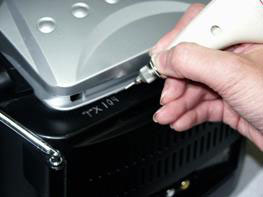
1977
A bomb was taped to the underside of a police car at police headquarters, rigged so that it would go off when the car was moved. The explosion could be heard for blocks, but fortunately the officer was not hurt. The perpetrator was identified four months later, a demolition expert in the Army. He said it was a practical joke. He was charged with a misdemeanor.
On March 7, David Anthony Gutberlet and an unnamed juvenile orchestrated an armed holdup of the Falcon Oil station at 3920 Excelsior Blvd. Gutberlet was described as at-large and out-of-state.
The Park Tavern was held up by a couple of masked men. No one was convicted, but the owner thought that the criminals were later convicted of armed robbery in Nebraska.
1978
Sometime before 1am on February 16, 1978, Elayne Galleries was struck by thieves who took off with seven Norman Rockwell paintings worth $145,000 and a Renoir valued at $150,000 (which turned out to be fake). Many of the pieces were on loan from Brown and Bigelow. They were insured. The Art Crime Law dictated that the theft was in the jurisdiction of the FBI. Much more on this story on our Elayne Gallieries page.
On the same night as the Elayne Galleries theft, the home of a collector of military paraphernalia, on the 3200 block of Rhode Island Ave., was robbed of his collection, including helmets, uniforms, swords, guns, and medals. The collector was frustrated at the lack of attention the SLP PD gave his case, and was asked to produce an inventory of the items stolen. Unfortunately, one of the items was a Medal of Honor – while it was legal to buy and sell other military medals, it was against the law to buy or sell a Medal of Honor. The case was turned over to the Army, but no charges were filed.
In April, there was a bomb scare at the Shakey’s Pizza Parlor at 6501 Wayzata Blvd. On a tip, police found a fake bomb in the trash can in the men’s room. The 88th disposal unit for Twin City Arsenal was sent to retrieve it, and it was sent to the FBI in Washington, DC for analysis.
Home Federal Savings at 3915 Highway 7 was robbed on a fairly regular basis. In July they fled on bikes. In January 1979 a Nazi helmet was left behind.
1979
City Manager John Elwell resigned after he lost a city car. Apparently he had picked up a hitchhiker at Lake and Hennepin, and the guest helped himself to the wheel and took off. This happened on March 29, and the car was found at the Parkway Motor Hotel, Hiawatha and Minnehaha Parkway, on October 1. Elwell tendered his resignation immediately, withdrew it a week later, but later resigned.
Employees of Citizens State Bank were stunned when fellow employee Ruth Barthel, the bank’s chief bookkeeper, pled guilty to embezzling $259,632 over a six year period. Much of the money went for trips to Las Vegas, Germany, and the Caribbean. The loss was insured. Barthel was found out when examiners checked the bank’s records on a day she called in sick.
On October 15, 1979, a homemade bomb was found in a restroom at Westwood Jr. High. Five Westwood students were found to be responsible. The bomb was found to be workable but misfunctioned.
In December, vandals smashed 25 windows at Ethel Baston Elementary School. The previous year someone got in and stole musical instruments.
1980
On January 24, Jay Terrence Lunow, 42, pulled a gun on a guard at Snyder Drug at Miracle Mile. He had hidden the shotgun in a duffle bag. The area was cordoned off, but he got away. Officers Gary Therkelsen and Thomas Hocking thought the description of the assailant was Lunow, and they went to the home of his parents where they knew he lived looking for him twice but the parents said they hadn’t seen him. The following day Lunow went to his ex-wife’s home and stole her car. She reported it and Lunow was stopped by the Golden Valley Police on Winnetka and Golden Valley Road. Lunow pulled out the .410 shotgun and fired on police. They returned fire killing him. Lunow’s parents told Therkelsen that he had been hiding in the garage with the shotgun when they had stopped by the night before but they were afraid to tell police as they feared there would be a shootout. Jay Terrance Lunow was well known by the St. Louis Park police department.
From December 28, 1979 to January 6, 1980, the City was under siege after four rapes had been committed in quick succession. Police apprehended Thomas Scott Wagner, 26 on March 13. A plea bargain resulted in his being charged with burglary and receiving and concealing stolen goods – but not rape. He was given 10 years at Stillwater for each count.
1981
Cheryl Rossi, 23, was found in a vacant lot in North Minneapolis with a gunshot to the head. She was alive, despite spending three nights in single-digit cold for three days.
On March 10, 1981, the Park Coin Shop was robbed of an estimated $60,000 in silver and gold coins and cash. The perpetrators took a bus to Chicago, where they bought a Lincoln Continental and drove to Lafayette, Indiana. There a motel clerk heard them arguing and saw a gun and called police. A handmade necklace linked the four people to the Park Coin Shop robbery and they were arrested. (SLP Sun, March 25, 1981)
On March 16, 1981, the Twin City Federal Savings and Loan Knollwood Office at 8020 Highway 7 was robbed by a man and a pregnant woman, with a third person driving a getaway car. A tip led the police to the car near Meadowbrook Road and Excelsior Blvd., and police followed it into downtown Minneapolis with the help of Minneapolis police, the FBI, and the State Highway Patrol. A search of a south Minneapolis home found two more suspects, and a sixth turned himself in. More than half the money was recovered. (SLP Sun, March 18 and 25, 1981)
The City ordinance outlawing massage parlors, saunas, and escort services became effective on April 1, 1981.
Radio Station WWTC, located at 2309 Brunswick, was burglarized twice in July, with losses estimated at $14,000. The thieves got away with radio and testing equipment and satellite system circuit cards.
The Bunny Hutch was owned by Daniel Bahler, 37, of 2544 Zarthan. His business operated out of 3130 Excelsior Blvd. in Minneapolis. He advertised: “a lovely woman to listen…to gently massage…to share your pleasures.” A notable feature was that his employees were eligible for Blue Cross/Blue Shield. The FBI investigated, and got him on insurance fraud: $10,000 fine and five years probation. His lawyer was Ellis Olkon. He was also prosecuted for promoting prostitution and attempting to distribute cocaine. He sold the Hutch in 1981.
David Corum of Brooklyn Center made his way to the Meadowbrook Women’s Clinic at 6490 Excelsior Blvd. and threatened to detonate a bomb, which turned out to be made of soap, gas, water, and a double boiler. He thought an ex-girlfriend might get an abortion there, and he was demonstrating against convenience abortions. At the time, Meadowbrook was the region’s largest abortion clinic.
Rina B. Fuff, 1840 Jersey Ave., was found stabbed and asphyxiated in her home. Police responded to an anonymous tip and also found her husband, Irvin, who was unconscious from the gas but was revived. He was charged with first degree murder and subject to a $150,000 bond. Mrs. Fuff worked at Qualitone Hearing Aids on 35th Street.
On November 15, 1981, Lauren Gail Andersen of 4246 Vernon Ave. disappeared from her parents’ home and was never seen again. Police arrested a suspect in her murder, but without any physical evidence, no charges could be filed.
1982
Alfred Clinton Trenholm shot wife Mary Ann three times with a shotgun on January 25, 1982, after she had served him with divorce papers. He was charged with attempted first degree murder. A Clinton A. Trenholm and wife Mary Ann are listed in the 1980 directory as living at 3311 Xenwood Ave.
In the continuing struggle to regulate prostitutes out of business, the City Council did give beauty salons the go-ahead to provide therapeutic massages as an incidental service accounting for no more than 20 percent of gross receipts. The change in the 1980 ordinance prohibiting massages except at health clubs by health care professionals was successfully lobbied by Eleanor Winn, who operated Body Dimensions, 5407 Excelsior Blvd.
Park school officials cracked down on student smoking with a vengeance. In the 1970s, smoking in the bathrooms was a common occurrence. Officials also tried designating an outdoor area where students could smoke, but that soon became a “pit.” Now students were issued tickets and faced suspension if they were caught. Going to McDonald’s was infeasible too, as Park police were stationed there and ready to issue tickets. Principal Wanio reported that there was little opposition to the new policy.
Vandals caused $1,700 in damage at the Westwood Hills Nature Center by using a tree branch to break windows. The culprits escaped on a yellow moped. Honeywell had just donated an alarm system to the Center the previous June.
Ronald Peterson’s Hair by Big Kids, at 4816 Excelsior Blvd. was cited for violating the City’s new massage parlor ordinance. The shop offered a tanning booth and massage.
HARRIET EISENBERG
Robert Eisenberg, 50, strangled wife Harriet to death at their home at 2067 Utah. Harriet, 50, was found beside her car. The Eisenbergs’ two grown children tried to convince the judge to reduce the charge to manslaughter, but Robert killed himself by carbon monoxide poisoning in his garage on December 7 while awaiting trial. Additional details come from Office Gary Therkelsen:
Early morning of March 2nd, 1982, I was patrolling in the “3941” district. I drove into the industrial area south of Cedar Lake Road and Edgewood and saw a car in the middle of a field with the dome light on and a door open. It had snowed that night and there were no tire or foot impressions visible so the car had obviously been there most of the night. When I approached the car I saw a partially clothed body of a woman who was later identified as Harriet Eisenberg who had turned 50 the day prior. The crime scene suggested criminal sexual conduct (rape) and murder. This was apparently staged to deflect suspicion from her husband.
Investigators were frustrated by the inability to connect anyone to the crime until they secured and performed a search warrant of the Eisenberg home. That didn’t reveal any real evidence until Investigator Pat Collins crawled into the attic and found the clothing that was missing from the crime scene and other evidence. Eisenberg was arrested, charged and ultimately committed suicide.
911
Before 911 emergency service was implemented, each locality had its own phone number for police emergencies. The Minnesota legislature found this untenable, and ordered statewide 911 service by December 1986, and in the Twin Cities area by December 1982.
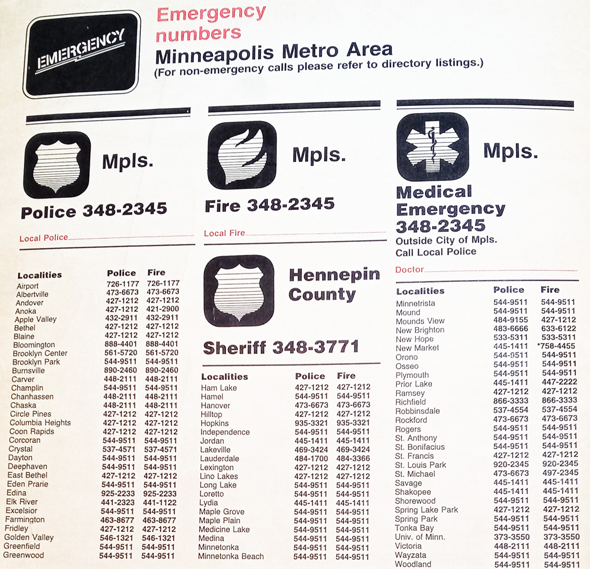
New, centralized 911 service was scheduled to come on line on November 1, 1982. It was advertised throughout the year, in part through the use of the five story hot air balloon shown below.

On December 1, 1982, entire Twin Cities metro area’s Enhanced 9-1-1 system came on line, and St. Louis Park’s 911 dispatch center (located in the police facility in City Hall) was one of 31 in the area to start taking calls. The St. Louis Park Dispatch ran a story on November 24 featuring a picture of Lt. Percy Morris. A “911 Telefair” on November 30 would launch the new service in the Park. The fair featured the hot air balloon, a 12 minute slide presentation, and a “911 Cheer” by the Parkettes.

Park native and ’64 Park High grad Paul Linnee, who had gone on to become a police officer and firefighter in Burnsville and then Richfield, was instrumental in planning the metro system, eventually taking over as the Minneapolis 911 Director for 10 years as well as Chair of the Metro 911 Tech Operations committee. Paul’s St. Louis Park roots run deep: he is the nephew of Enoch Arthur (E.A.) “Art” Linnee, who served as the Park’s Justice of the Peace (later Municipal Court Judge) for several terms (see 1942, above), including presiding over a case of bad motorist behavior by miscreant Linnee in 1962, resulting in an appropriate penalty. Linnee had another SLP uncle, Torval Jorvig, who spent 33 years on the Park’s City Council in the 50s to the 70s.
Paul described the significance of the region-wide switch to 911 emergency service:
Back then, Enhanced 9-1-1 was quite rare in major metro areas and we were told that our system, encompassing 7 counties, 200 municipalities and public safety agencies, 31 call centers, 7 phone companies and 2.2 million residents at that time was the largest such cut-over at one time anywhere.
1983
The Tri-State Agencies, Inc., 4412 Excelsior Blvd. was owned by Dale Thomas McCauley. He and three employees plead guilty to forgery and theft by forging the signature of an 80-year-old woman on a Medicare supplement insurance policy. Another employee fled to avoid prosecution.
It was a bad night at the Classic, that March 16, 1983. Employee Mark Holdridge was found yelling and intoxicated by police after they responded to a call about a broken window at 3:45 am. Holdridge pleaded guilty to breaking the window and was given a 10-day suspended sentence. Then, the restaurant’s manager was fined $110 for allowing unauthorized persons on the premises after hours. Two other employees were fired, and the manager, Michael Zachar, was busted down to bartender. In response to this mayhem, the City Council voted to suspend the bar’s liquor license on June 15, 1984.
After buying stolen goods for 15 months, undercover officers, Police executed a successful sting on April 19, 1983. The investigation focused on burglary, fencing, and sale of drugs. Warrants were issued for 91 individuals, and police recovered $175,000 of stolen property, including cars (including a Corvette with 18 miles on it), photographic equipment, video equipment stolen from a WCCO van, computers, firearms, musical instruments, and jewelry. Marijuana, cocaine, speed, and PCP with a street value of $100,000 were also confiscated.
91 people from 10 communities were arrested under Operation UNICORN. Perps were taken to the Rec Center for fingerprinting and photographs. The average age was said to be just over 21, with several juveniles held. 96 percent of those arrested were white males.
The sting was the culmination of a 15-month investigation involving the FBI, ATF, U.S. Postal Inspector, Minn. Bureau of Criminal Apprehension, Hennepin County Sheriff, and the Minneapolis, Hopkins, Bloomington, Richfield, Golden Valley, Minnetonka, New Hope, Plymouth, and Edina police departments. Once the results of Project Unicorn (Undercover Investigations Centering on Residential Neighborhoods) were announced, callers flooded the phone lines to see if their stolen property was recovered. 81 of the 91 arrested were convicted.
In 1983 the police department had 65 employees and 35 volunteers.
Leaning Post owner Phil Eder was arrested on December 26, 1983, for resisting arrest and assaulting an officer. A call was received that a waitress had been assaulted by two female customers after they were cut off. When officers arrived, Eder tried to prevent them from talking to the waitress. Incidents like this undoubtedly led to the reputation of the Leaning Post as a tough bar.
A brou-ha-ha erupted over a billboard advertising the Lion’s Club Pancake Breakfast in April. Naegele Outdoor Advertising erected the sign on the property of S&D Cleaners, 4501 Excelsior Blvd. The sign was in conformance with the City’s ordinances, but might not have been had the City acted on a revised code tabled in 1979. Neighbors were up in arms about its proximity to their property and about 60 of them came to a City Council meeting to register their views.
1984
The cremated remains of a man’s mother, stowed in a gym bag in the back of his car as he stopped in St. Louis Park for the night on January 7, were stolen. Later, other items in the gym bag were returned, but no mom. That April, a member of the Minneapolis Park Police found the urn in a city park and turned it over to the Hennepin County Medical Examiner. The ashes finally made their way to Lakewood Cemetery.
Mancel Mitchell became Police Chief on October 1, 1984. He was the first Police Chief who was hired from outside the St. Louis Park PD.
1985
Chief Mancel Mitchell started up a rash of personal arrests when he collared a Federal fugitive who had shoplifted clothes from Knollwood. Then on March 28, he spotted three armed robbers driving on Cedar Lake Road and made chase. And on November 18, Chief Mitchell spotted suspects while riding in his unmarked police car, pulled them over, and arrested them. This time, he heard a call go out for a car carrying three women who had forced themselves into an elderly woman’s house and stolen her checks. After the collar, the press and Park police officers started referring to Mitchell as “Chief Earp.”
Robbers took off with over $10,500 in a March 16 robbery at Snyder Drug in Miracle Mile. After asking for foot powder, the man forced a female employee to give him the money, then bound her with fiberglass tape.
Gypsies were back! In May, a homeowner at 32nd and Alabama had her house ransacked by a Gypsy woman in her late 40s, dark-skinned, speaking with a foreign accent, and wearing a hat with a 2-inch brim. Police warned residents against such scam artists, who sometimes tried to sell shrubbery or lightning rods. See 1913, 1934, 1964.
The City installed its first yellow and white Neighborhood Watch sign at the corner of Hamilton and Zarthan in June. The program had started in 1983.
On August 23, police estimated that about 100 pro-lifers picketed Methodist Hospital to protest abortions performed at Meadowbrook Women’s Clinic. The group claimed that the clinic was owned by Methodist, a statement denied by the hospital. The 3-1/2 hour rally was the first of many demonstrations planned by Peace of Minnesota. The group claimed that 120,000 abortions had been performed at Meadowbrook since it opened in 1972.
Three officers of the St. Louis Park firm Kitco, Inc. a/k/a Krown Manufacturing Co. were issued a permanent injunction and were ordered to pay the FTC $531,949 in damages for losses suffered by the company’s customers. The company was accused of defrauding customers by selling them machines to make plastic paint roller trays and signs and falsely promising to buy back their products. The three officers were Duane F. Snelling, a/k/a Harvey Butterfield of Las Vegas (owner and president), Craig A. Jesinoski, and John E. Farkas of Minnetonka.
McGRUFF HOUSES
A 1995 community handbook tells about McGruff Houses:
Some neighborhoods have McGruff Houses: homes where children can go if they find themselves in an emergency or frightening situation while walking in a neighborhood. McGruff Homes are identified by a poster and provide children with a safe haven to make a phone call. Participants have undergone a law enforcement records check and have been trained by the St. Louis Park Police Department.
It is unclear how long or how extensive this program was in the Park. The McGruff House program closed down nationally in 2012:
In February 2012, the National Crime Prevention Council, the Utah Council on Crime Prevention, and the McGruff House Network announced the end of the McGruff House® and McGruff Truck® programs after a 30-year successful run. The world has changed significantly in those 30 years, and with children carrying personal cell phones and other electronic devices, changing social and neighborhood dynamics, new business models, and ever-tightening budgets, the partner organizations could no longer sustain the program. Program coordinators have been notified and instructed to collect and destroy all signs and program materials.

1986
Police Chief Mancel Mitchell, already known for three arrests since his tenure began, made another on April 22, 1986, when he heard a call on the way to work and arrested a youth in a stabbing incident. Then on July 9, 1986, he arrested three teens trying to cash a forged check at the Twin City Federal branch at Knollwood.
Dr. Paul L. Warner, a psychiatrist working at the Christian Mental Health Center in St. Louis Park, had his license restricted by the state Board of Medical Examiners because he had sexual contact with two female patients between 1972 and 1977. He said he had been involved with the Christian evangelical movement for many years.
The body of St. Louis Park resident Marjorie Ann Buscher, a 19-year-old hitchhiker with a mental age of 12, was found by the side of the road in Sumter County, off I-95, stabbed several times in the chest and back. She had been traveling the U.S. since September 1985 – before that she had been confined to a state mental hospital. Police explored the possibility that she was murdered by a serial killer that focused on redheads.
Former St. Louis Park councilman Jerrold Martin was accused of receiving favorable treatment on personal real estate transactions from two developers after voting in favor of the developers in their dealings with the council. The Star and Tribune reported that Martin was a real estate agent and former police officer. He served on the city council from 1977 to 1985, stepping down voluntarily at the end of his term. The developers involved were the Darrel A. Farr Development Corp. and Shamrock Builders, Inc.
1988
A four-month sting operation yielded 13 arrests and recovery of more than $110,000 in stolen property. About half of those arrested that February were from St. Louis Park. Included in the dragnet were six vehicles, several boats, motors, sports equipment, cash, credit cards, and drugs.
1989
On October 27, 1989, a crowd of 50-150 youths gathered outside of the Roller Garden. Several fist fights broke out, and an officer was struck while making an arrest. Five juveniles were arrested.
On November 5, 1989, police were again dispatched to the Roller Garden. Shots were fired from two cars in a dispute that somehow had to do with someone’s sister. Five men were arrested and three weapons were seized.
On November 12, 1989, acting on a tip, police approached a group of men on the street outside the Roller Garden and confiscated a number of weapons. One arrest was made.
1990
More trouble near the Roller Garden, where three people from St. Paul were hit with two shotgun blasts. Owner Bill Sahly had hired off-duty police and changed formats to more family fare to try to cut down on the violence, and the City had moved a bus stop to prevent milling around. The City also raised Sahly’s license fee, citing costs to police the area, which Sahly vehemently protested.
Ron Wilson was sentenced to 450 months in prison for killing his estranged wife, Cynthia Schlegel-Wilson in July. The victim had been bound, beaten, and stabbed at her home on 13th Lane. The couple had a history of domestic violence and he had been under a restraining order.
The jail and locker room of Police headquarters in the basement of City Hall were condemned. From May to December, prisoners were sent to the Hennepin County jail, and officers changed in a conference room.
John Heidelberger went to Federal prison on charges of mail fraud and mail theft. The 37-year-old mailman had been stealing credit card applications from people along his route and buying things with them. Police identified 44 credit card applications stolen from patrons in the northwest part of the Park. To conceal the existence of the credit cards, he stole monthly bills and other correspondence from the credit card companies, and even sent change of address notices to the companies to divert the monthly bills. The scheme went on from July 1986 to February 1990, and he and his wife charged approximately $155,000 worth of merchandise and cash.
1991
Park police took possession of 3,712 pornographic videotapes from an apartment at Menorah Plaza, 4925 Minnetonka Blvd. A 52-year-old man was caught trying to sell them through the newspaper, from the building next to the police station. Selling adult movies is not illegal unless they are pirated and/or the actors are underage.
1992
St. Louis Park native Brian Maas was shot and killed at the gun shop where he worked on June 23, 1992. He was employed at Lloyd’s Sport Shop, 4831 Lyndale Ave. No. Thieves took as many as 100 guns in the robbery. Maas was a 1974 graduate of St. Louis Park High School.
1993
Somewhat related to police and crime was the Women’s Gun Shop, which operated at 4530 Excelsior Blvd. It was opened in August 1993 by 21-year-old Nikole Christianson, who wore a loaded .38 Colt in the waistband of her jeans. The shop concentrated on education, providing pamphlets, books, and a four-hour self defense course for $99, taught by Christianson and John Holm. Holm taught martial arts for over 40 years, and both he and Christianson taught the judo class in Adult Extension at the U of M. They also taught defense tactic classes to both police and FBI.
In July 1993, over 200 protesters belonging to several “pro rights groups” (as reported by the Sun-Sailor) chanted, blew whistles, beat drums and shouted at members of Calvary Temple, 9500 Minnetonka Blvd., arrived for services. They were opposing the church’s support of the Operation Rescue anti-abortion demonstrations, one of which was held at an abortion clinic in Robbinsdale the day before. The church’s pastor, Rev. Lawrence Reves, had helped coordinate Operation Rescue activities. Seven people were arrested at the Calvary protest, including an Associated Press photographer, some under the state’s new stalking law. Police from Robbinsdale, Maple Grove, Edina, Minnetonka, Minneapolis, and the State Patrol responded to the situation, escorting church members and using mace to subdue protesters. Many of the protesters were from out of state; some men wore dresses and wigs, and some women held a “kiss-in” during the protest.
St. Louis Park attorney Edward M. Cohen, Sr., 61, was disbarred by the Minnesota Supreme Court, and faced four felony charges of theft by swindle. 13 allegations of unprofessional conduct were filed against Cohen, who lived in Minnetonka and practiced at the Parkdale Plaza Building at 1660 Highway 100. He was accused of taking $290,000 in client funds. He also took more than $100,000 from his mother to replace funds he’d taken from his clients. The charges also stated that he had engaged in misconduct with clients, violated court orders, neglected client matters, overcharged clients, forged signatures, lied to clients, and impeded the investigation against him.
The owner of Airlink Travel Agency, 4820 Excelsior Blvd., pleaded guilty to federal mail fraud in connection to a bogus insurance claim operation involving bogus accidents in Nigeria. Akindele A. Akinola and two others operated the scam out of the Airlink office. They also submitted false claims to airlines claiming lost luggage. Akinola told an informant, “It’s the American way.”
St. Louis Park Police moved into their new headquarters at 3015 Raleigh Ave., across the parking lot from City Hall, where it had been located since 1963. The new $3 million police station was dedicated on September 19, 1993. It was the first time that the police department had its own facility. The architect was Boarman, Kroos, Pfister and Associates, and the builder was Adolfson and Peterson, Inc.

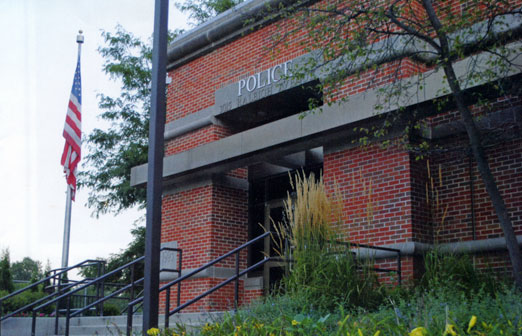
Minneapolis police raided Duggan’s Bar and Grill in November 1993, seizing gambling sheets and paraphernalia. The case started when a Minneapolis police officer on another case followed his suspect into Willie’s Bar in the rear of Duggan’s. At that time, he witnessed illegal betting on football, with waitresses and bartenders as participants.
1994
Seven employees of Musicland, 7500 Excelsior Blvd., were charged with stealing compact disks and players from the warehouse. Surveillance cameras helped identify the thieves.
Rev. Gordon and Nancy Peterson, pastors at Calvary Temple, flew to Norway to attend the Olympics in March but were denied entry into the country. The Petersons and 10 other Americans were anti-abortion activists, invited by Norwegian clergy to participate in pro-life activities. The next day, the painting “The Scream” was stolen, and one of the Norwegian ministers told the press that it might be returned if an anti-abortion film “The Silent Scream” was broadcast on national television. Although they were detained, suspicion was pointed at the Americans, who had spent time in jail before for anti-abortion activities.
1995
John Bryson Vogel, 52, was accused of printing more than $19 million in fake bills in January 1995. Some of the fake bills were seized from a mini-storage facility in the 3800 block of Louisiana Ave. in St. Louis Park. Vogel confessed that he passed the counterfeit bills throughout the United States for the past 1-1/2 years. He was released on bond January 17. He failed to show at his court hearing on January 23, and the chase was on. Cut to July 12, when he held up the First Federal Savings and Loan in downtown Sioux Falls and led police on a 50-mile car chase, that ended in Rushmore, Minnesota when he shot himself to death in the head.
Fantasy Gifts was owned by Robert, Colleen, and Stevie Beritno. The store, which sold adult novelty lingerie, toys, and gifts, first came to St. Louis Park in 1983, located at 5810 Excelsior Blvd. In 1995, the shop moved to 4814 Excelsior, and at that point the City filed an injunction, saying the store was in violation of the city’s adult-use ordinance. The judge disagreed, and the business was allowed to continue.
1996
St. Louis Park resident James Pilot, 24, savagely beat and raped a Hopkins woman in her home on May 11, 1996. Pilot was the ex-boyfriend of the victim’s best friend. The victim let Pilot into her home when he came looking for her friend and her friend’s baby. In February 1997 Pilot was sentenced to 22 years in prison, seven years longer than state guidelines for first-degree criminal sexual conduct. Pilot was also sentenced to 15 years for attempted murder, but wouldn’t have to serve that time if, when he was released from prison in about 2012, he kept away from the victim and her family for another 20 years.
Five month old Promise Jones was found dead of asphyxiation in her St. Louis Park home on November 16, 1996, by her four-year-old brother while the children were alone in their house with their father John Jones. Jones had kicked his wife, Tracy Jones, out of the house during a fight, and one theory was that he killed Promise in the hopes that her death would bring his wife back to him. Jones was sentenced to 10 years in prison for first degree manslaughter. The jury acquitted him of intentional murder and felony murder. Jones had previous convictions for spousal abuse and assault of his son. The family lived on the 3300 block of Texas Ave.
2000
Patricia A. Hoover, 61, was convicted of embezzling $102,000 from Citizen’s Independent Bank from 1991 to 1998 using money orders or cashier’s checks made payable to Torah Academy, but cashed them herself. She was sentenced to one year in prison, restitution, and 250 hours of community service in 2000.
Keith A. Kirkendahl, 37, also known as Jemel Hakim, was convicted of second-degree intentional murder for killing Serene Mankoff, 76, with a dumbbell in her house in the 3300 block of Zarthan Ave. So. on April 1, 2000. He received a sentence of 38 years, 9 months. Kirkendahl had sexually abused Mankoff’s daughter and threatened to kill her family if she told police. He was on probation for a sex crime and was afraid of being sent back to prison.
James D. Banks, 50, was beaten to death with a shovel at his home in the 3600 block of Quebec Ave. So. Leonard Q. Young, 25, of St. Paul was charged with second-degree unintentional murder. Banks had allegedly sexually assaulted an acquaintance of Young. The alleged assault victim initially told police that she had beaten Banks and was charged with supplying false information to police. Young was convicted by a jury in March 2001 but a new trial was ordered due to improper activity by a juror. Young waived his right to a jury retrial and asked for a lesser charge, but was was convicted of second-degree intentional murder and sentenced to more than 14 years in prison.
2004
A bar fight at Bennigan’s in St. Louis Park ended in the death of Roger Y. Hamilton on January 15, 2004. Hamilton, 49, died at the scene of a blow to the head. Cousins Charles J. Dessalliers, 22, of Massachusetts and Phillip J. Desalliers, 24, of Plymouth were charged with second-degree murder, second-degree manslaughter and fifth-degree assault. The three had been playing pool when Phillip allegedly thought the victim was flirting with his girlfriend. In a jury trial in December 2004, Charles was found not guilt on the grounds that he was acting in defense of his cousin. Charges against Phillip were dismissed in June 2005. Hamilton’s children sued Bennigan’s for serving drinks to the cousins when they were obviously intoxicated.
On May 24, 2004, Michael C. Francis, 21, of Burnsville killed Pamela Ragland, 21, and wounded Marvin Pate, 23, of St. Louis Park after an argument about tire rims. The shooting took place in the 3300 block of Portland Ave. So. in Minneapolis; Francis’s alibi was that he was with his girlfriend in St. Louis Park but she did not testify. Francis was found guilty of two counts of first-degree murder and two counts of attempted first-degree murder. He received life in prison for the murder and an additional consecutive 15 years for the attempted murder.
On November 9, 2004, Abdisalam A. Hussein, 29, of St. Louis Park took part in a robbery to obtain the drug khat during which a woman was killed. He pleaded guilty of aiding and abetting first-degree robbery. Yasmin Geelle was murdered in her apartment in Minneapolis during the botched robbery.
2005
Shalom Home West Nursing Director Mark E. Wetsch was sentenced to three years and 10 months in prison for stealing $1.4 million from the facility from 1997 to 2005. He used the money for home improvements, vacations, four vehicles, three snowmobiles, a private running coach, private school tuition, tickets to sporting events, and things: he sold a pool table, kayaks, skis, watches, and golf clubs to pay restitution.
Kirill Geilman, 56, killed his girlfriend Roman Kidane with a carving knife on August 25, 2005, at her apartment at 4400 Minnetonka Blvd. The Minneapolis Tribune reported “Geilman, who is from Russia, testified that Kidane threatened to call the Russian Embassy and say he was an FBI informant. He said he had a vision of his three children in Russia shot dead.” After he slit her throat, he called police and said “I killed my girlfriend just now.” Geilman was convicted of second-degree intentional murder in February 2006.
2006
Teddy L. Roark, 45, was charged with dousing his girlfriend with rubbing alcohol and setting her on fire on April 4, 2004. The couple lived in the 2700 block of Louisiana Court in St. Louis Park. The attack was in response to her decision to leave him. Roark had been convicted six times of domestic assault or terroristic threats involving the woman. He was charged with first- and second-degree attempted murder and first-degree assault.
2007
On April 21, 2007, Dameon D. Gatson, 22, paid his friend Paul A. Peterson, 18, both of Hopkins, to punch Gatson’s pregnant girlfriend in the stomach in order to cause a miscarriage. Peterson went to Shyloe Linde’s apartment on the 5600 block of Minnetonka Blvd. in St. Louis Park and assaulted the woman for $200. The baby was born the next day but was taken off life support nine days later after doctors determined she would suffer from devastating medical problems. Peterson plead guilty to intentional second-degree murder and first-degree assault in 2008 and was given a 40-year prison sentence. Peterson appealed his sentence on the grounds that it was not murder because he did not kill a human being but the appeal was rejected by the Minnesota Court of Appeals. In October 2009 a jury convicted Gatson of first- and second-degree murder for the killing of the baby and first-degree assault.
2008
On July 24, 2008, Michael Collins Iheme shot his wife, Anthonia Iheme, 28, as she sat in her car in the parking lot of Sholom Home West in St. Louis Park. The car lurched forward, clipped a van, jumped a curb and rolled down a hill into a fence. Iheme followed the car down the hill and fired more shots. Iheme, 50, a Nigerian immigrant, then called police and said “I have killed the woman that mess my life up.” The murder followed the relevation that Iheme was not the father of the couple’s youngest child. There was a record of domestic abuse charges and an active harassment restraining order was in force. At his sentencing, Iheme said that God had forgiven him, but he was sentenced to the maximum of almost 32 years in prison.
2009
MoneyGram International Inc., which was founded in St. Louis Park, paid $18 million to settle allegations by the FTC that it allowed its money transfer system to be used by fraudulent telemarketers in Canada who bilked US consumers out of more than $80 million from 2004 to 2008. In 2010, MoneyGram paid $80 million for defrauding investors by hiding its exposure to the subprime mortgage crisis. The company’s headquarters moved to Dallas in 2011, but retains operations in St. Louis Park and Brooklyn Center. In 2012 MoneyGram admitted to aiding and abetting wire fraud and failing to maintain an effective anti-money laundering program between 2004 and 2009.
Suresh Harlan Small, 28, of St. Louis Park, was sentenced to 240 months in prison on five counts of armed bank robbery. He stole approximately $296,304 in five bank robberies in 2007 and 2008, including robberies of the Twin City Federal Savings and Loan in St. Louis Park on February 1 and March 13, 2008. After his final robbery he led police on a high-speed chase and was shot after brandishing what appeared to be a handgun.
2010
St. Louis Park resident Howard Charles DeBoise, 56, was charged with second-degree intentional murder for killing his wife Barbara, who had recently moved out of the home. She was found with multiple stab wounds after DeBoise called a relative and said “Your sister is dead. She is lying on the kitchen floor, but I didn’t do it.” The murder took place in the 4000 block of Excelsior Blvd. He had a long history of abusing and intimidating his wife. Police caught him stranded by the road near Willmar with $5,000 and his passport.
32-year-old Pamela Jean Beaulieu was found stabbed to death at the Lakeland Inn on November 18, 2010. Shards from a broken mirror had been used to cut her throat. Beaulieu had just been released from the Hennepin County workhouse after serving five months on a drug charge. She had at least 43 convictions in Minnesota, for prostitution, drug offenses, and auto theft. James A. Reed was arrested near Chicago and held on $3 million bond. He was convicted of second-degree murder in July 2011. Two other men were arrested but released. The Lakeland Inn, 4025 Highway 7, was a hotspot for criminal behavior – police had been there 203 times since the beginning of 2009. It has since been demolished.
St. Louis Park resident Michael Richard Swanson, 17, robbed two convenience stores in Iowa of $31 and some cigarettes and then killed the clerks, Vicky Bowman-Hall and Sheila Myers. Swanson had attended elementary and junior high school in St. Louis Park and had recently been sentenced to a stay at the Hennepin County Home School. He had been enrolled at Park High and working at Cub foods just before his rampage. He was found guilty of first degree murder of Sheila Myers and pleaded guilty to the murder of Vicky Bowman-Hall. He was sentenced to life in prison without parole.
2011
On October 3, 2010, David Maxam, 55, the estranged husband of Stephanie Maxam of St. Paul shot and killed her in the Parkdale Plaza parking lot, in the 1600 block of Highway 100. He called police to tell them to go to East 37th and Hiawatha Ave. When they got there, they found that he had shot and killed himself. The 51-year-old victim was a senior vice president at US Bank and the mother of four children.
2012
Rena Christine Dobervich, 26, was charged with two counts of second-degree assault with a dangerous weapon for stabbing her boyfriend with two steak knives on August 15, 2012.
The system for adjudicating citations for violating city ordinances shifted from the Hennepin County Courts to the City in August 2012. Avoiding the cumbersome County system allows more City departments to issue more citations.
On August 22, 2012, Austin Christian Grove, 19, of St. Louis Park, and another man were charged with second-degree assault with a dangerous weapon, a felony with a maximum penalty of seven years in prison and a $14,000 fine. Police were called to a home in the 7900 block of West 26th Street where a man reported being slashed with a knife after telling the suspects to stay away from his grandson.
In September 2012, St. Louis Park resident Joel Delano Powell, Jr. was convicted by a Federal jury for his role in a large, multi-state identity theft ring that operated from 2006 through 2011. Powell was convicted of seven counts of bank fraud, five counts of aggravated identity theft and one count of conspiracy to commit bank fraud. Three other men were also convicted in the case.
On Halloween 2012, Orrin John Hager was angry because he thought some boys had stolen his child’s Halloween candy, so he pulled an AK-47 assault weapon from his car and threatened them with it. It happened at 27th and Brunswick. The gun turned out not to be loaded. On February 26, 2013, he pled guilty to second degree assault and was sentenced to 120 days in the Hennepin County Adult Corrections Facility. Judge Daniel H. Mabley also ordered Hager to pay a $500 fine. In April he was allowed to serve his sentence at home.
Antonio Frasion Jenkins Jr., a St. Louis Park resident when not in jail, was charged with threatening a Minneapolis police officer by posting a photo of a tattoo on Facebook that specifically targets that officer. In January 2013, Jenkins was exploring ways to remove the tattoo.
2013
In the early morning hours of Feb. 28, 2013, David Vassily Robakevich, 25, crept up to his former girlfriend’s bed as she lay there, and began whispering into her ear that he was going to kill her. He tried strangling her, then hanging her from the ceiling fan, and pouring alcohol on her, all while reciting prayers in Russian. She escaped to a friend’s house and was so traumatized that police had difficulty persuading her that she was safe. Meanwhile, Robakevich called police and reported that his apartment had been trashed. He was arrested and held on $250,000 bail in the Hennepin County Jail. He faces one count of Second-Degree Attempted Murder and one count of Felony Domestic Assault by Strangulation.
Brenden Robert Kreb faces one count of disorderly conduct for being offensive, abusive, noisy or obscene and one count of obstructing the legal process by interfering with a peace officer after a six-hour standoff at a home on the 3100 block of Nevada Ave. on June 9. After an argument with a woman in the house, Kreb mixed it up with a neighbor, who told police that Kreb’s eyes were bloodshot, his actions were erratic and he appeared to be under the influence of drugs. Kreb barricaded himself in the house and told police over the phone they would have to “come inside and shoot him because he had nothing to live for.” Police eventually got him out and took him to Methodist Hospital and then to the Hennepin County Jail.
On July 17, 2013, U.S. District Court Judge Paul A. Magnuson sentenced St. Louis Park resident Joel Delano Powell, Jr., 47, of one count of conspiracy to commit bank fraud, seven counts of aiding and abetting bank fraud, and five counts of aggravated identity theft. Also sentenced were Joell Delano Powell III, 20, of Minneapolis and Trey Jeremiah Powell, 20, of Brooklyn Park, who pleaded guilty to one count of conspiracy to commit bank fraud and one count of aggravated identity theft. They were part of a ring of 26 people who purchased expensive merchandise with counterfeit checks and ID and returned it for cash. They also withdrew funds from bank accounts using phony ID.
On September 17, 2013, the body of Nerissa Annette Shaw was discovered wrapped in bed sheets behind Angstrom Analytical, Inc., at 5001 Cedar Lake Road. Shaw, 46, had a violent relationship with Walter Thompson III, 54, who was the immediate suspect and who was arrested in Minneapolis. Thompson was on probation for violating an order for protection involving Shaw. Court records show he has a lengthy criminal history, including multiple charges of indecent exposure, criminal sexual conduct and domestic assault. Thompson was charged with second-degree murder but the grand jury indicted him on a first-degree charge. In November 2014 he pleaded guilty to second degree murder; if he had been tried an convicted of first degree murder he would have received a mandatory life sentence. Because of the plea, a judge sentenced him to almost 40 years in prison. Shaw’s sister, Senaca Ann Thompson, and daughter, Rachel Lee Thompson, are accused of helping him move and dump the body. (SLP Sun, December 11, 2014)
On September 20, 2013, a man living at Minikahda Court Apartments called police to report that his roommate, John Louis Thompson III, age 21, had sent him a text message announcing that he intended to kill someone. When the man came home he found a letter written by Thompson saying that he often thought about killing people and that he was considering using a rifle to shoot into a crowd, stabbing people, and setting off a bomb. The letter said “Tonight, I’m going to kill someone. If I enjoy it, then I guess it’ll be high-time for me to get to work on one of my ingenious plans for mass-murder.” The letter warned that if the roommate took the letter to police he would kill his co-workers, friends, and family. Police confiscated the letter and several knives and other weapons. Thompson was apprehended and charged with a felony count of making terroristic threats. On October 23 bail was set at $100,000 with conditions of release that Thompson have no contact with the victim, witnesses, or the apartment.
In November 2013, Marion Guerrido lost control of the Pontiac Grand Am that she was driving and the car landed in a deep holding pond at Highways 7 and 100. Guerrido escaped the car but five children, all under the age of eight, were trapped inside. Two of the children, including one belonging to Guerrido, perished in the accident. The car, which was not insured, belonged to the cousin of the father of three of the children. The father had driven to his workplace in SLP, then Guerrido took the wheel. She only had a learner’s permit which did not allow her to drive without a licensed driver. The children were also not in child seats as required. Hennepin County decided not to prosecute her for any felonies, but the St. Louis Park City Attorney’s Office charged her with misdemeanors for driving without a proper license, driving an uninsured vehicle, and a petty misdemeanor for failing to use proper child restraints. She plead guilty and was sentenced to 90 days, 30 under electronic home monitoring, and the rest stayed while she was under probation for one year. (SLP Sun, December 11, 2014)
On Nov. 29, 2013, Willie B. Porter, Jr., a 22 year old Minneapolis man, helped his sister and her two children move into an apartment on the 8000 block of 28th Street and then left for several hours. He returned intoxicated and his sister asked him to leave. He became extremely upset and began to swear at his sister and her two children, threatening to kill all three of them. The sister successfully called 911 although Porter tried to rip the phone out of her hands. Police found that Porter had had a blood alcohol percentage of .23. Porter had previously been convicted of felony domestic assault in January 2012. He faces up to a year behind bars and is being held on $30,000 bail.
2014
James Hance, owner of Hance Ace Hardware in Hopkins, was killed in a head-on car collision that occurred on April 15, 2014, near Minnetonka Blvd. and Ensign Ave. Hance, who lived in Brooklyn Park, was on his way home for a family party for his 75th birthday. He died early the next day. Hance had been driving westbound on Minnetonka Blvd. when a vehicle driven by Jorge Juarez, 20, crossed the center line. Juarez pleaded guilty to two counts of criminal vehicular homicide, admitting that he had smoked marijuana and taken Zanax before driving, and texting and driving nearly 20 miles faster than the speed limit. At the scene Juarez told police that he had no memory of the crash and did not know which street he had been driving on. (Sun Sailor, November 20, 2014)
2015
On October 9, 2015, Fasel Mohamed Ali, a custodian at St. Louis Park High School, was charged with fifth-degree criminal sexual conduct after allegedly making non-consensual sexual contact with another school employee. If convicted of this gross misdemeanor, he faces a maximum sentence of one year in prison and a fine of $3,000. He also faced a charge of second-degree driving while impaired and refusal to submit to a chemical test. Still another charge was fifth-degree assault relating to the infliction or attempt to cause bodily harm. Ali, 39 and a resident of Minneapolis, was an employee of Command Center, a contractor for the school district.
For more bad behavior, see Liquor in the Park, which also includes all drug-related crime.
CHIEFS OF POLICE
Andy Nelson (1888-1970) became Chief of Police on January 3, 1933, and served until June 30, 1959.
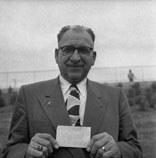
Clyde Sorenson became Chief on July 1, 1959. He retired as Police Chief on March 15, 1974, to work for the company that supplied security for Cedar/Riverside.
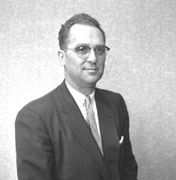
Richard Setter became the new Chief in 1974 and served until August 1984, when he resigned to become the Chief of the Minnetonka Police Department. Lieutenant Percy Morris served as Acting Chief.
Mancel Mitchell was sworn in as Chief on October 1, 1984. Mitchell served until 1997 when he resigned to become Chief of the Metro Transit Police. Captain Rod Walker served as Acting Chief.
John Luse, a sergeant in the SLPPD, was appointed Chief in 1997.
Lieutenant Mike Harcey was appointed as St. Louis Park’s 6th Chief of Police. He took his Oath of Office at the City Council meeting on March 20, 2017. Harcey had been with the SLP PD since 1991. He will retire on December 16, 2022.
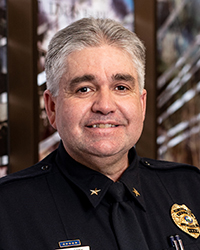
JUVENILE DELINQUENCY
Juvenile Delinquency was on the minds of many parents, as the teenage culture was born in the mid 1950s and Elvis and his ilk frightened many an upright citizen. Such concerns first surfaced during World War II, as children grew up with absentee soldier fathers, and war working women. Girls were also picked up trying to hitchhike to army camps to see their boyfriends. In November 1943, Earl Hoskins, liquor control commissioner, praised the Village Council on “efforts to help exterminate juvenile delinquency by the appointment of Mrs. Mildred Fagin, Policewoman.”
There was good news in 1951 when a U of M study found juvenile delinquency was at an “amazingly low level.”
A 1955 ad for National grocery stores took credit for turning potential JD’s into bag boys and checkout girls – 5,655 of them.
In November 1955 sessions on juvenile delinquency were held at the Hennepin County Court House, supposedly at the request of students. Speaking at these sessions was Paul W. Keve, Director of Court Services, District and Juvenile Courts.
In 1963, an article in the Dispatch declared “Blame is Placed on Home Life!”
In 1965 kids were getting rougher, with reports of them hanging around Miracle Mile and Knollwood, smoking, harassing customers, and blocking sidewalks. At Halloween the Minnesota Emergency Community Corporation helped the police spot Halloween vandalism.
Bad boys from St. Louis Park were sent to the county-run Glen Lake School for Boys (formerly a TB sanitarium). A third offense took you to Red Wing. For girls, there was the Penn School for Girls, but that was shut down in 1951. Hennepin County operated a small girls’ school, but it was abandoned in 1953. [These may be the same facility.] After that, delinquent girls were sent to private institutions, foster homes, or to the State-operated Home School for Girls at Sauk Center. An unfortunately undated article in the Minneapolis Tribune discussed a forthcoming county facility for delinquent girls at Glen Lake, making it a co-ed institution. The plan called for five new boys’ cottages (24 per cottage) and two cottages for girls. An educational building would be built and the building then serving boys would be an administrative office. Whether this plan was implemented is unclear. Mrs. Sally Olson of the League of Women Voters, speaking as a private citizen, challenged the plan, saying that the county should be planning space for three times the number of girls and that the State, not the county, should be responsible.
A 1969 article in the Echo stated that all court-adjudicated offenders in the Twin Cities area were sent to the reception center at Lino Lakes. After about a month of observation and testing, From there there are several options:
-
send the youth home
-
probation
-
group home
-
foster home
-
Red Wing – with vocational training
-
Sauk Centre – co-ed facility with state certified teachers
-
St. Croix Youth Camp – forestry work
-
Hibbing-Grand Rapids Youth Camp – forestry work
In 1969 the juvenile officer for the St. Louis Park Police Department was Duane Johnson. In 1968 his department had contact with 792 youth offenders.

